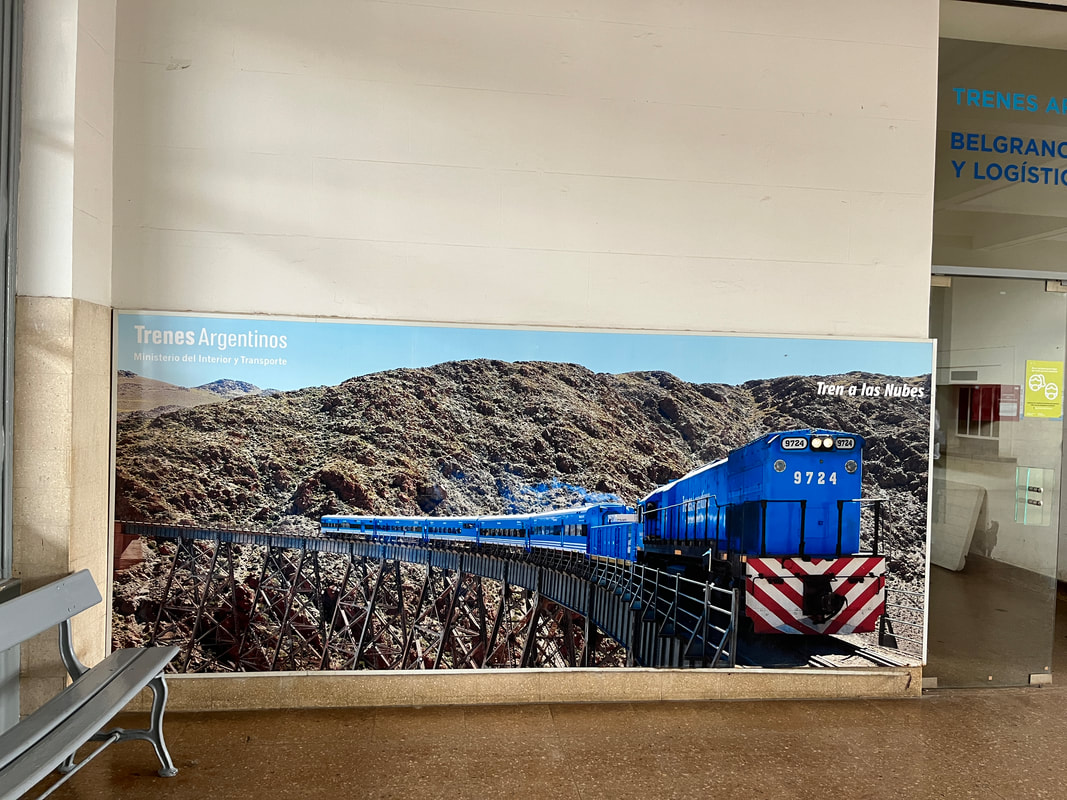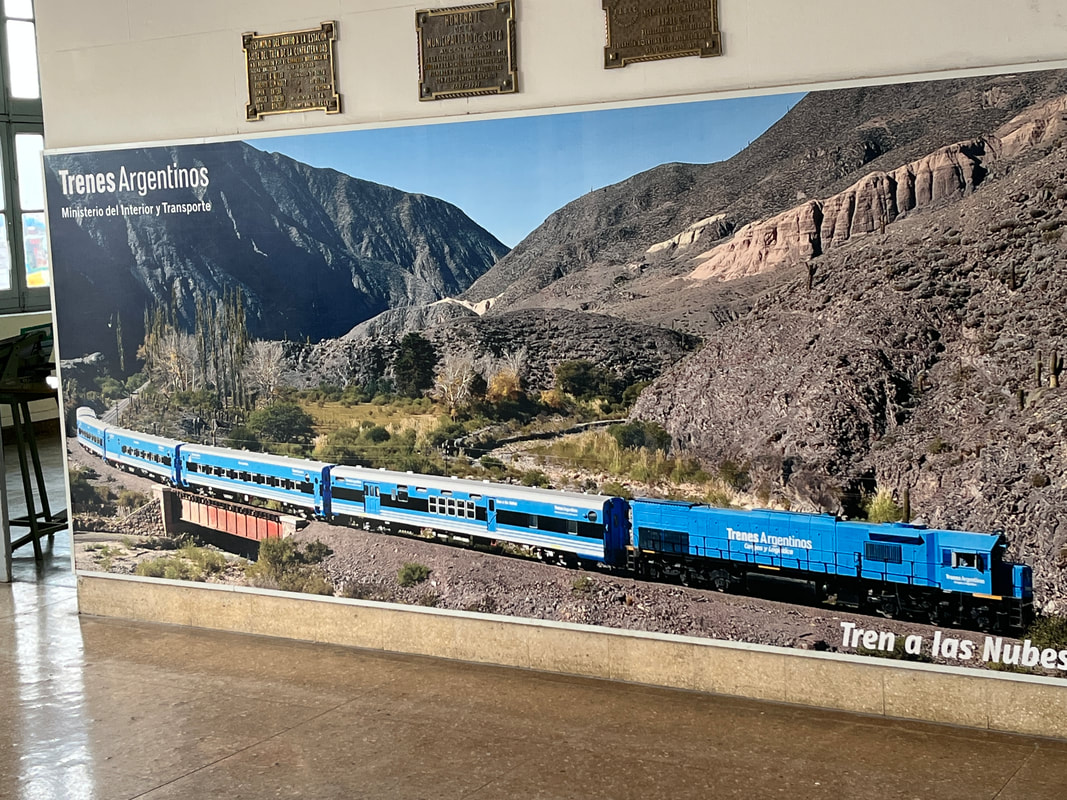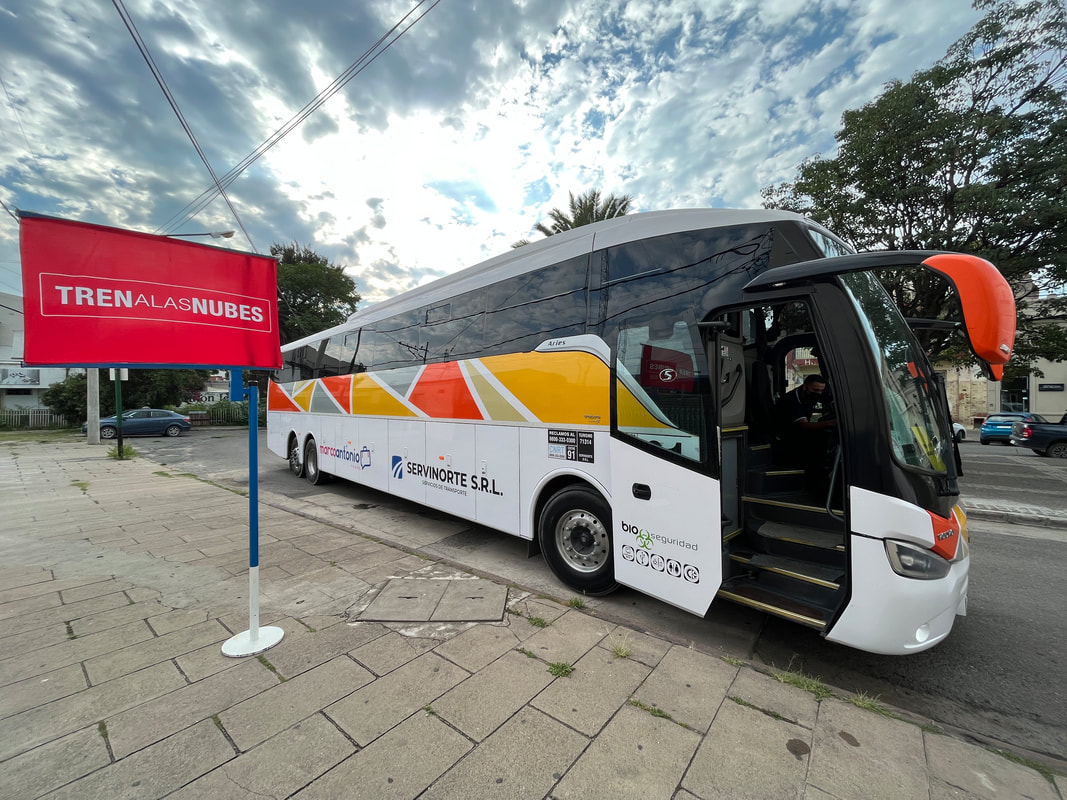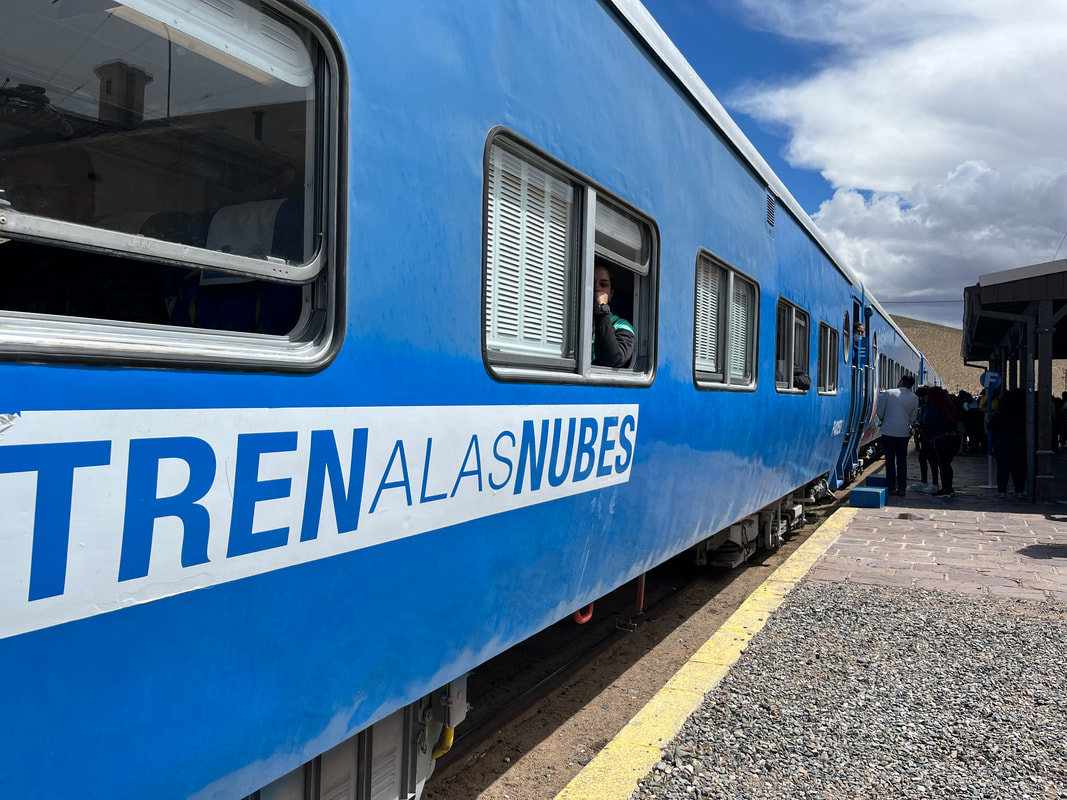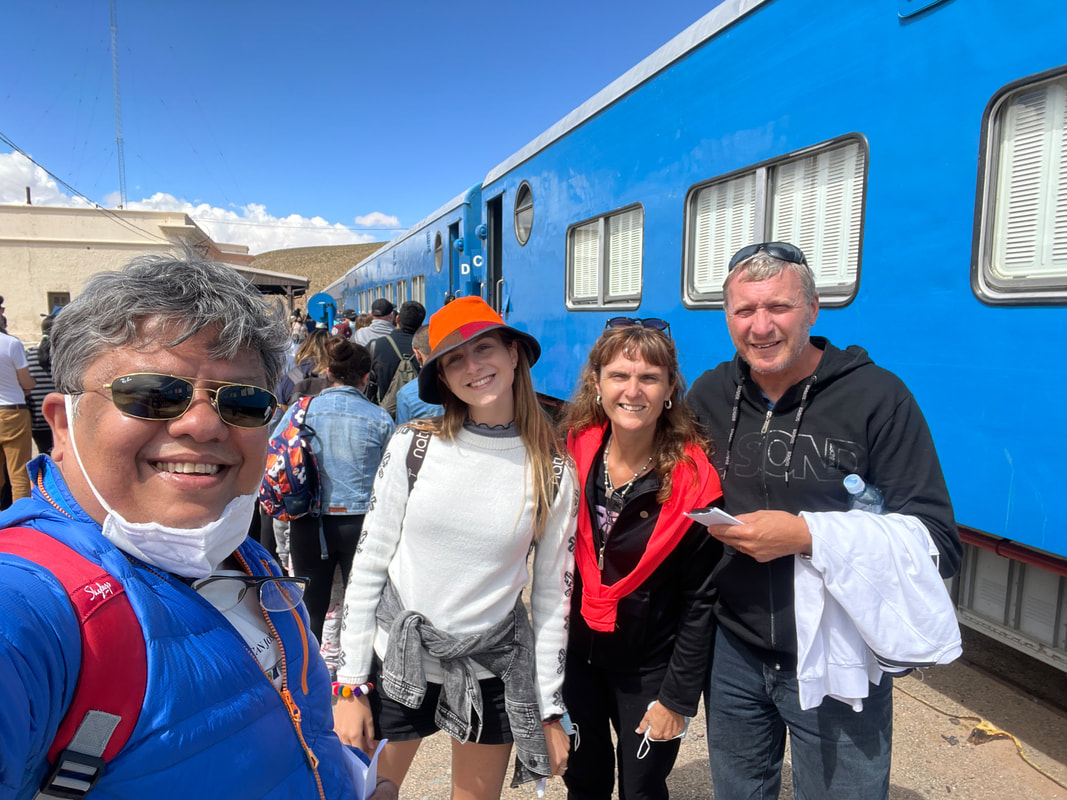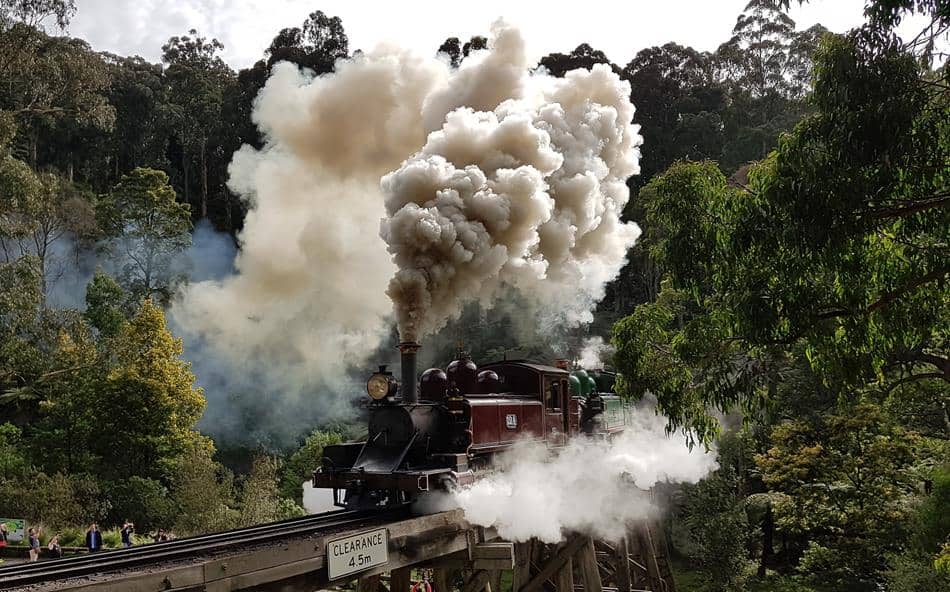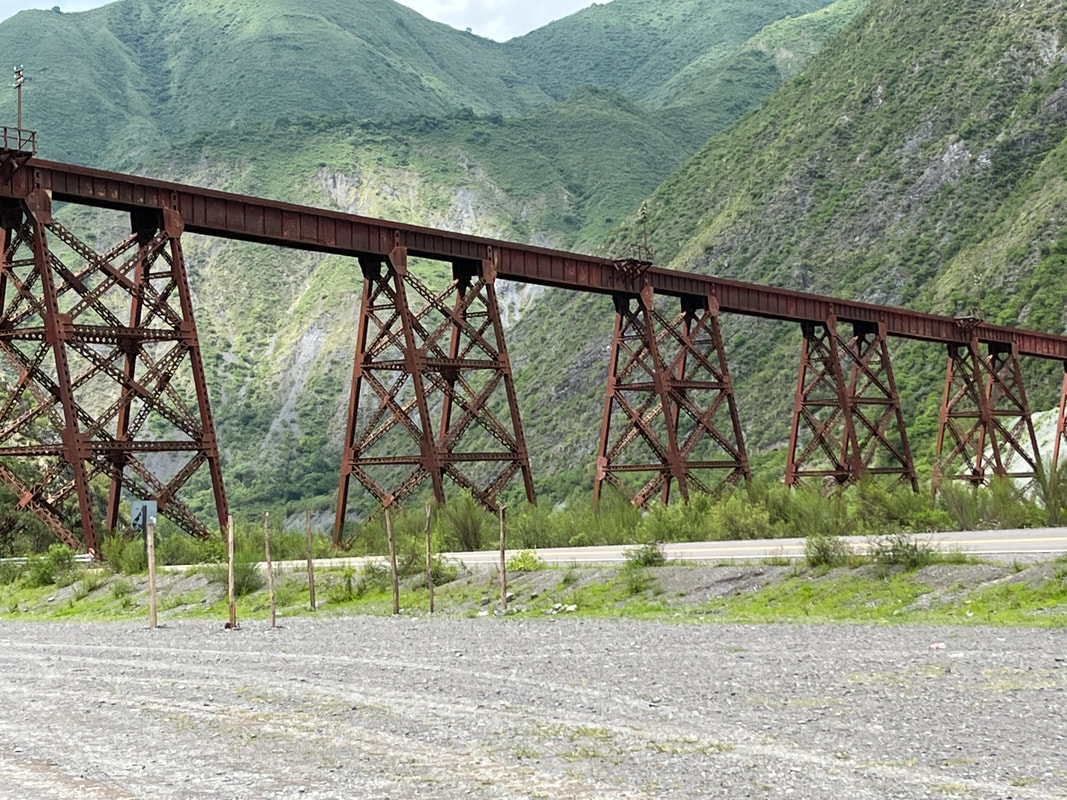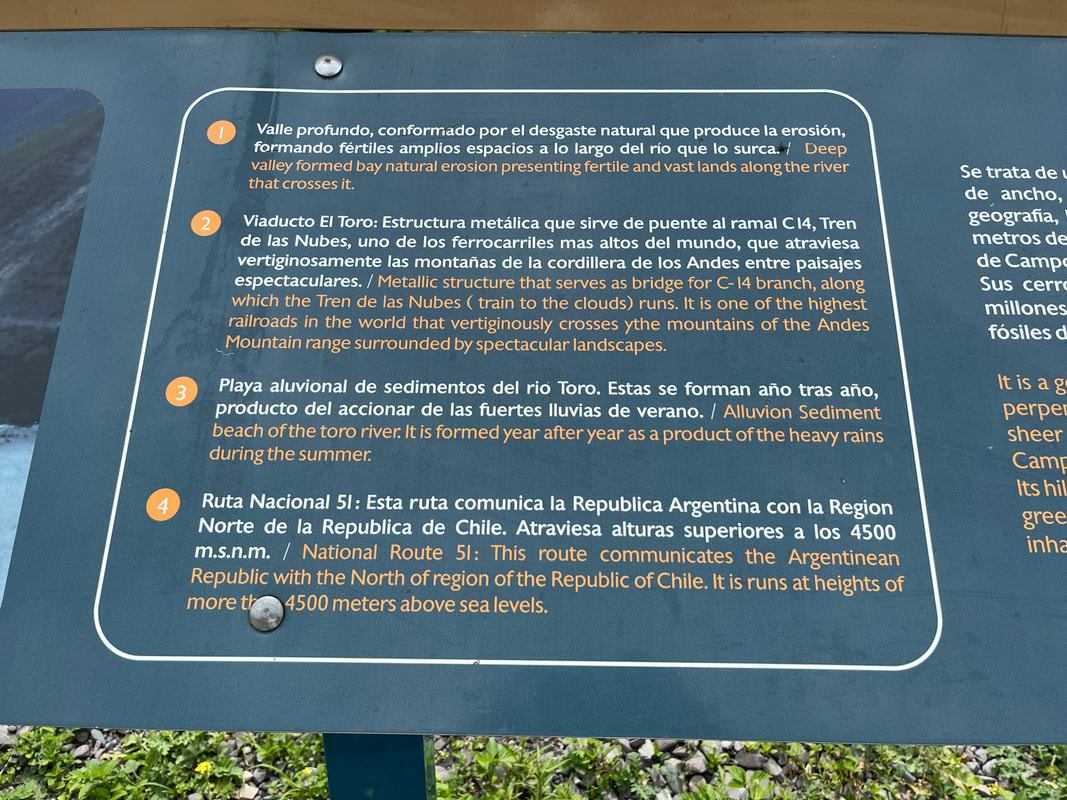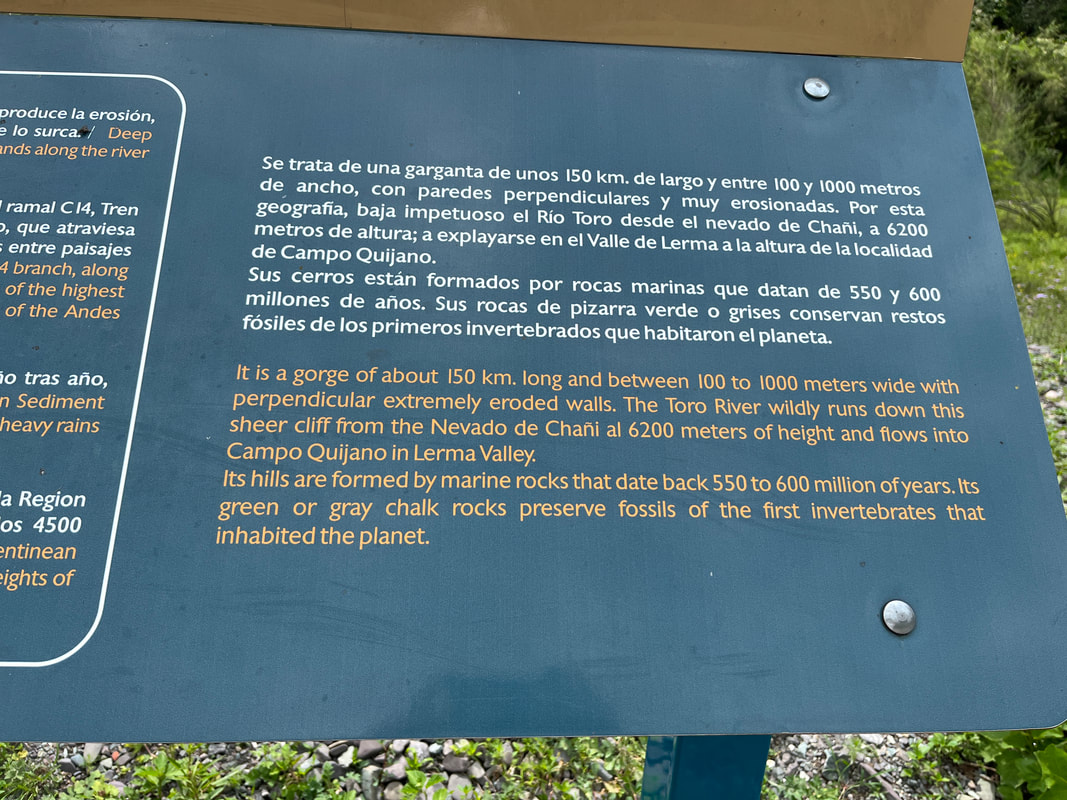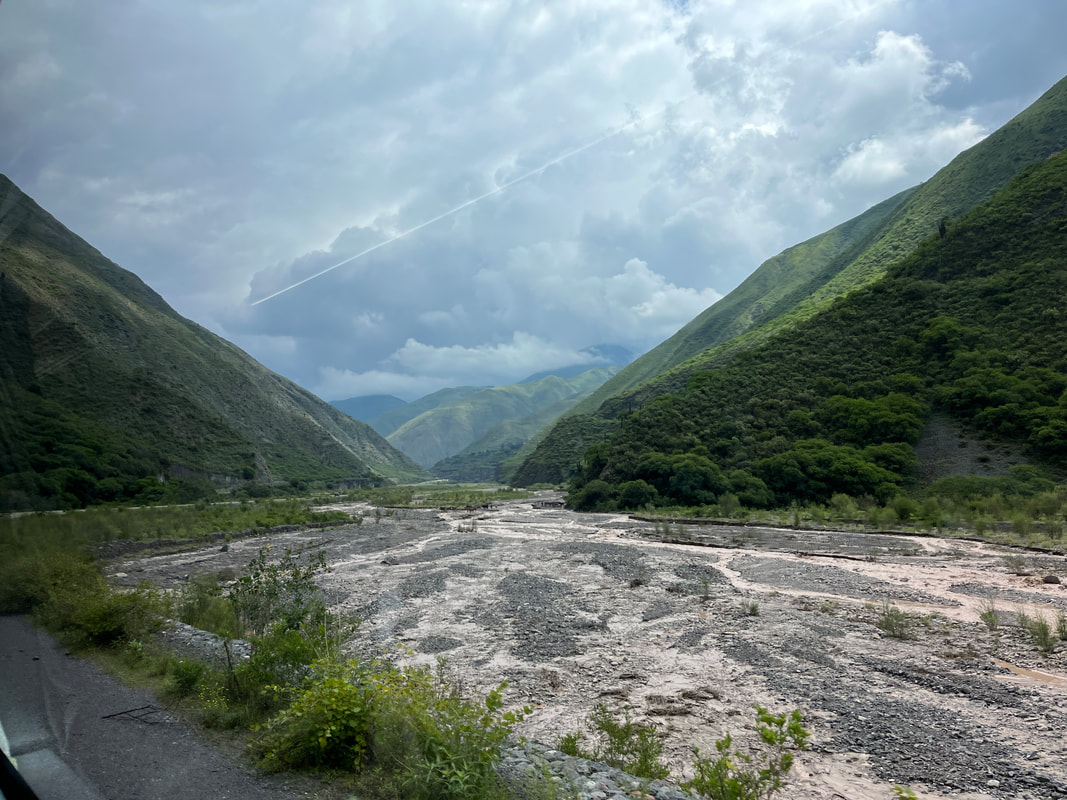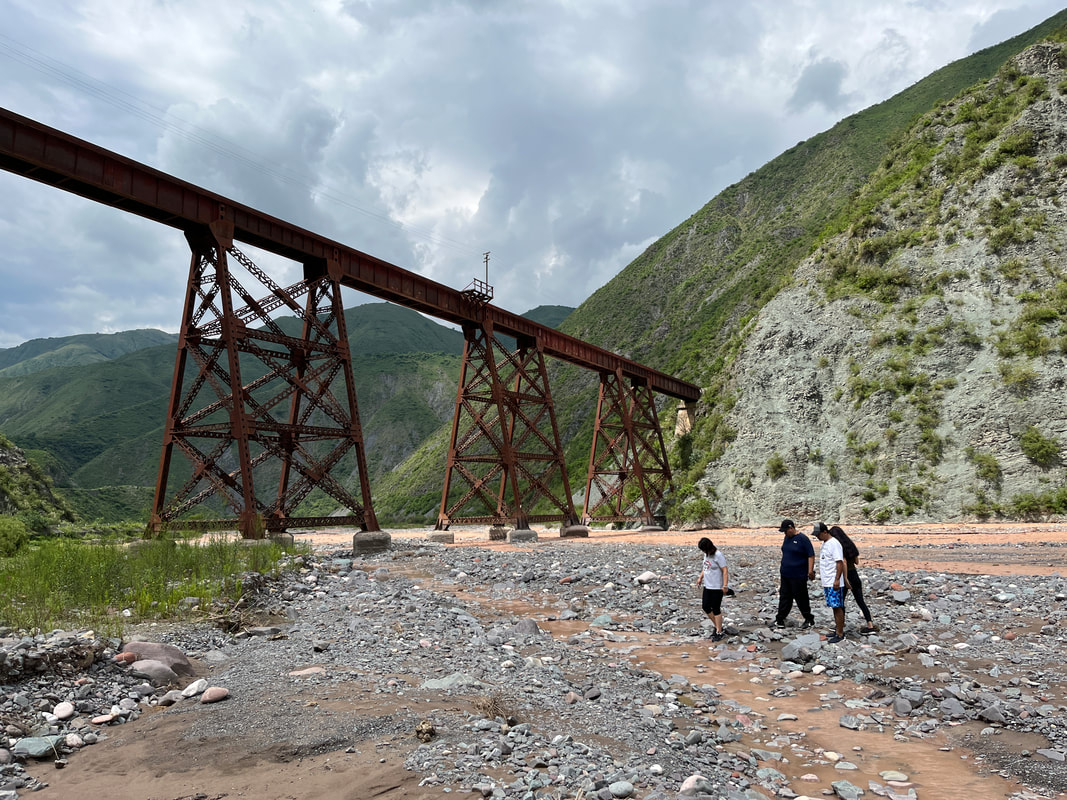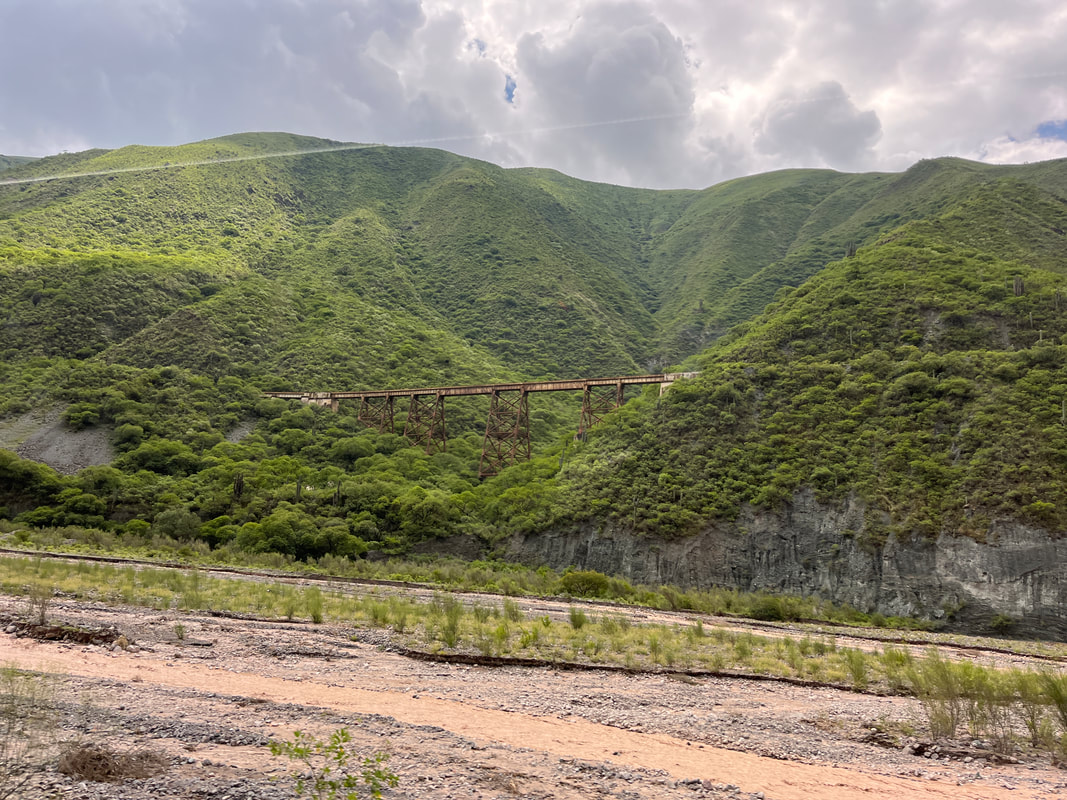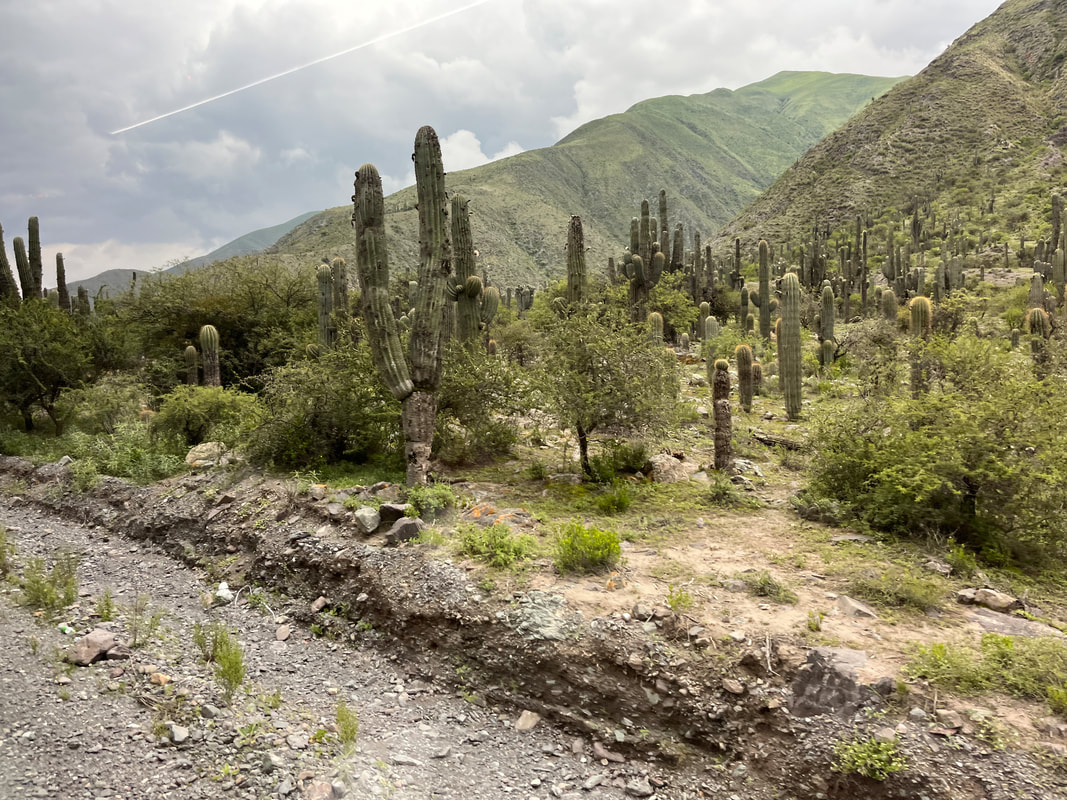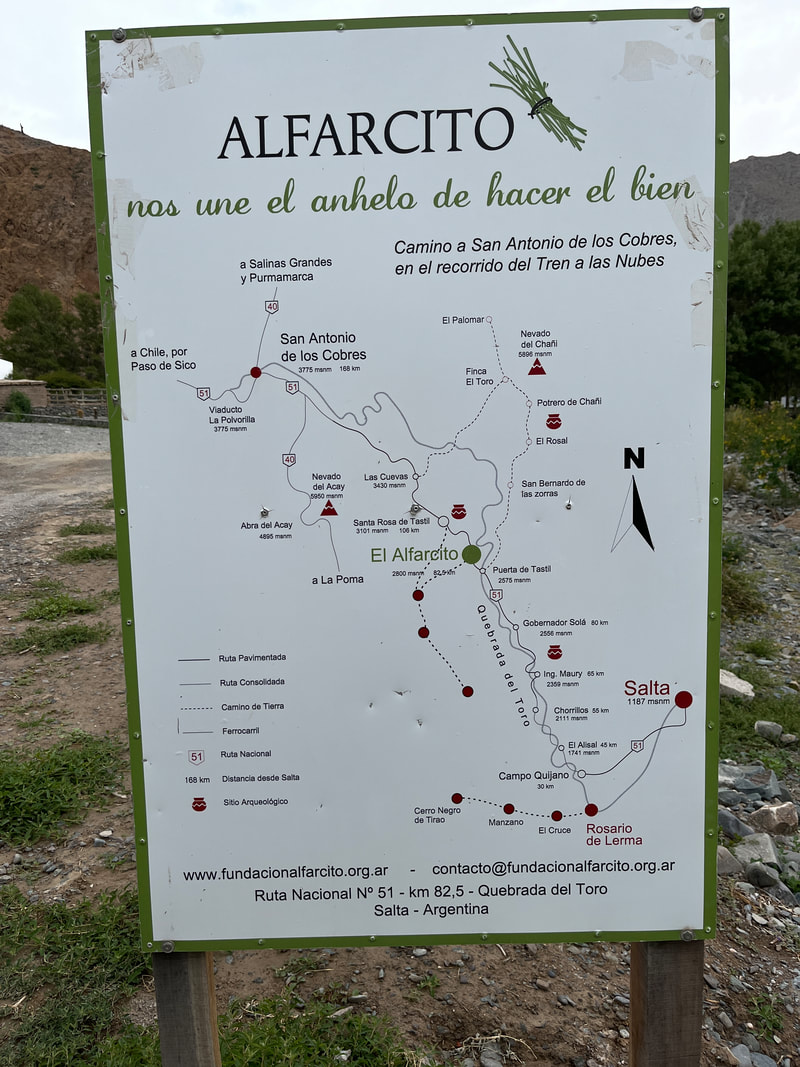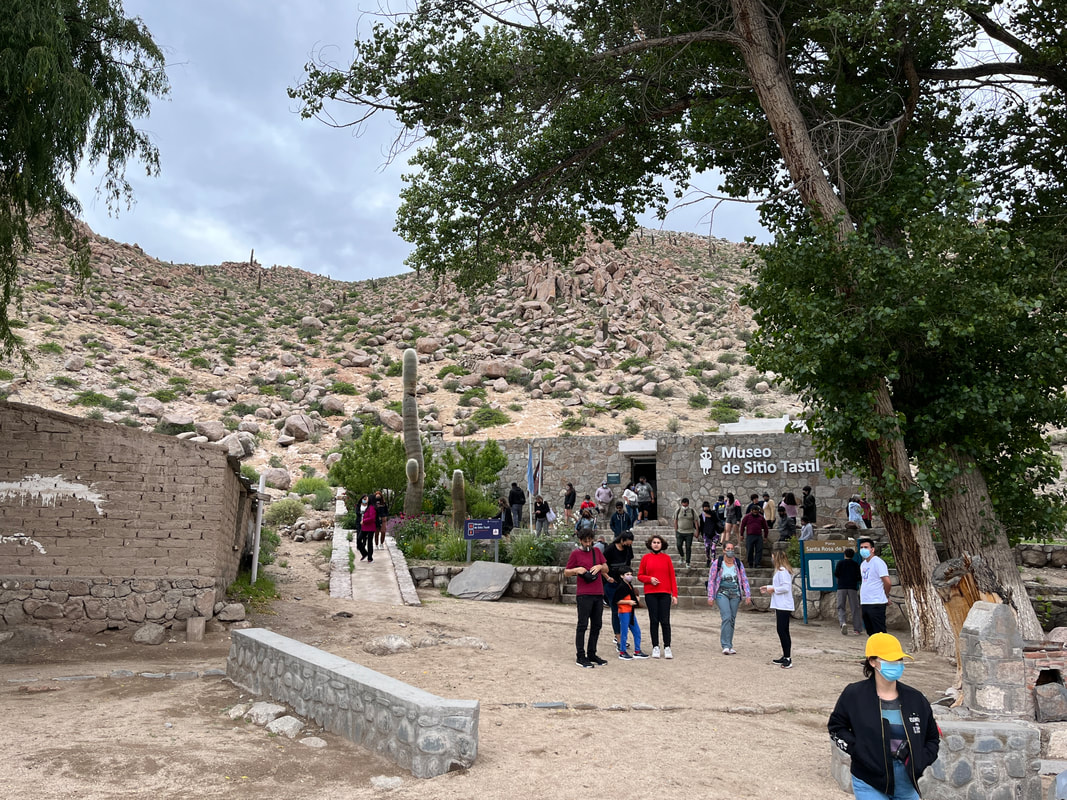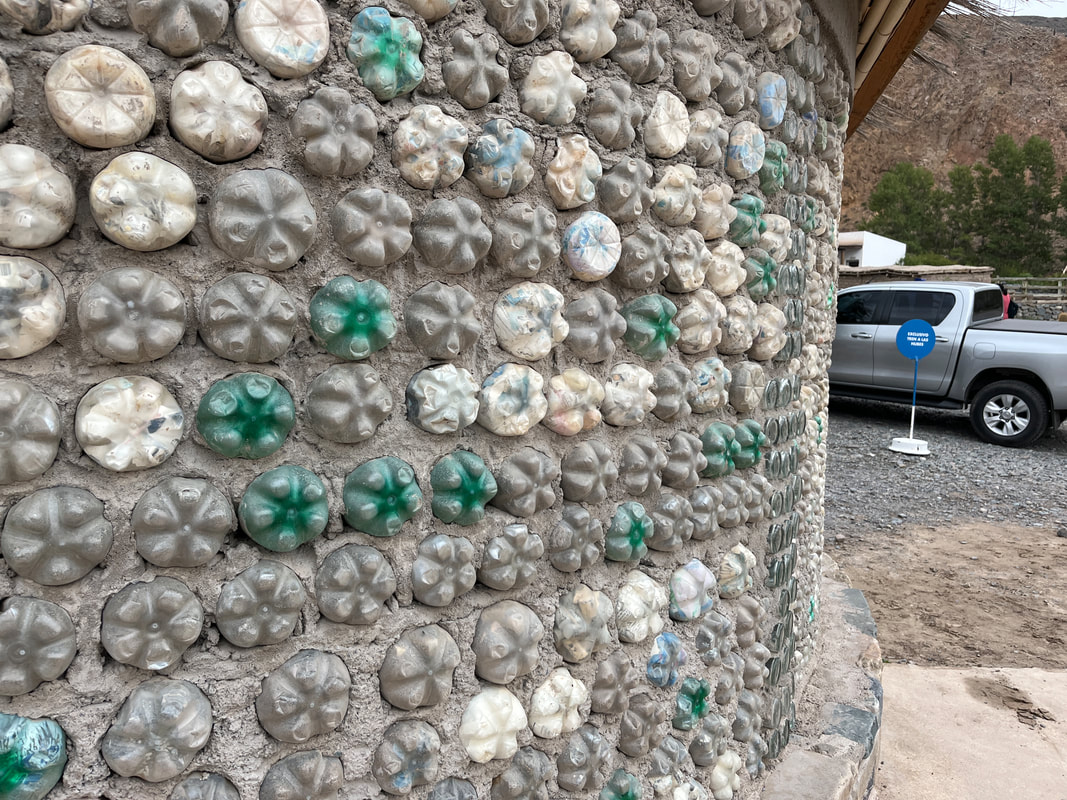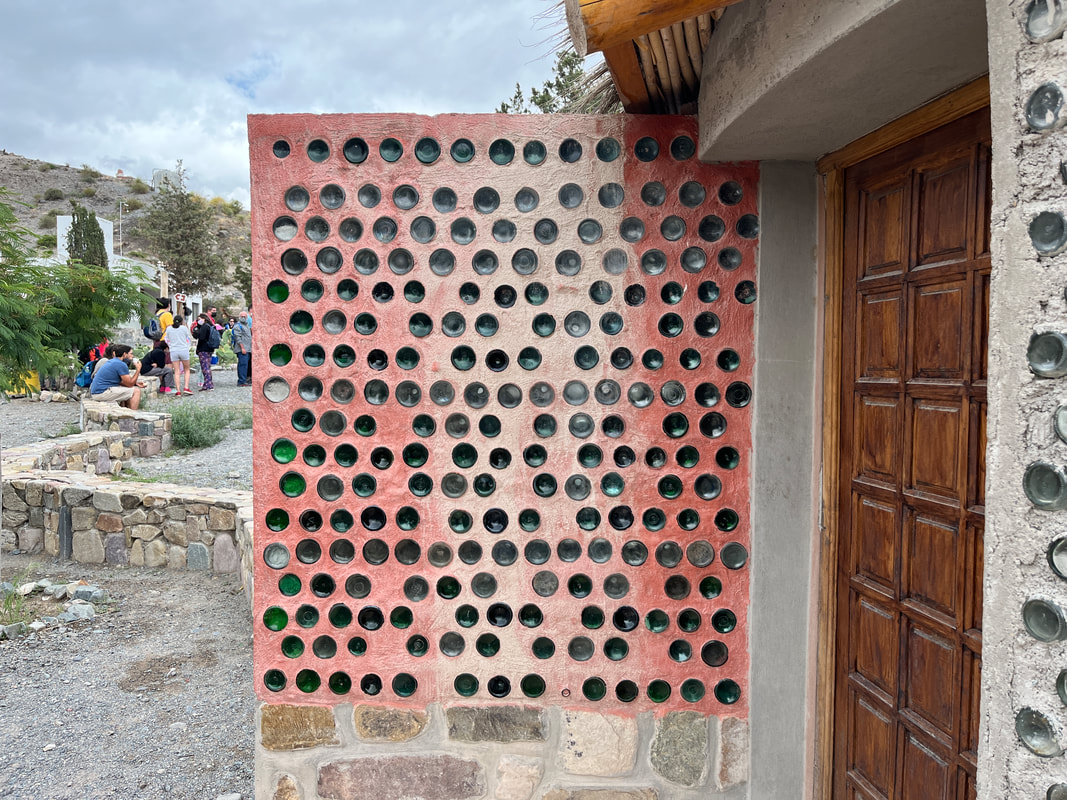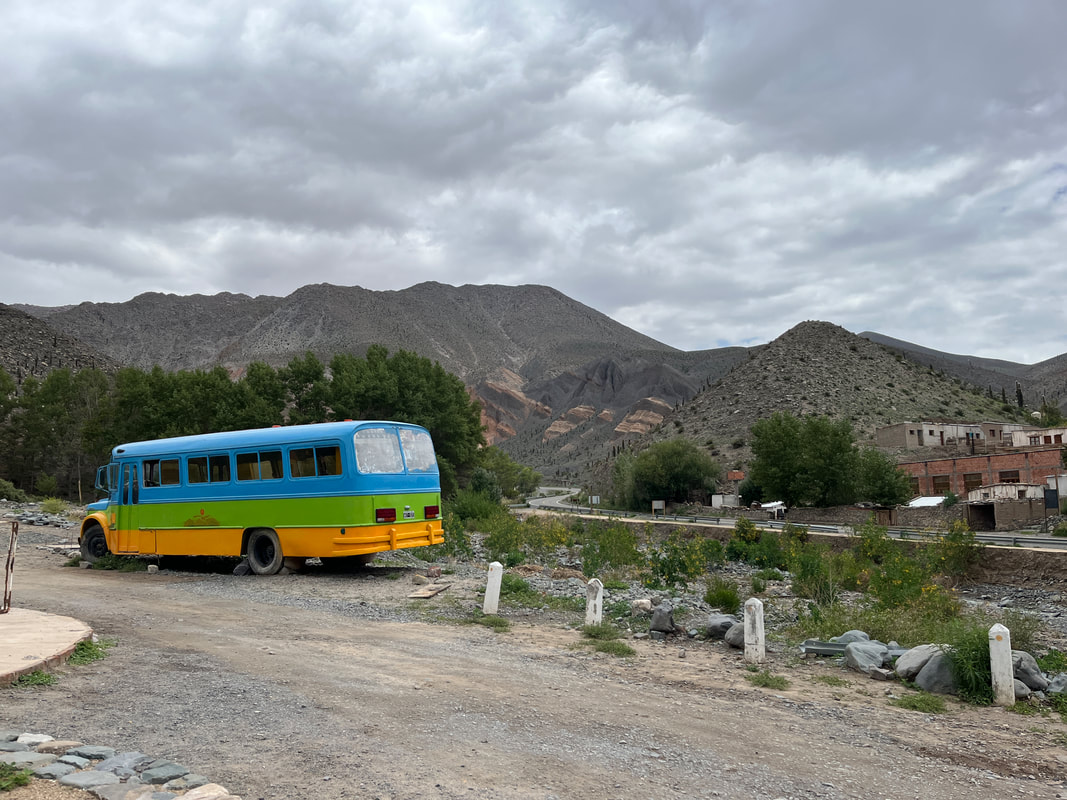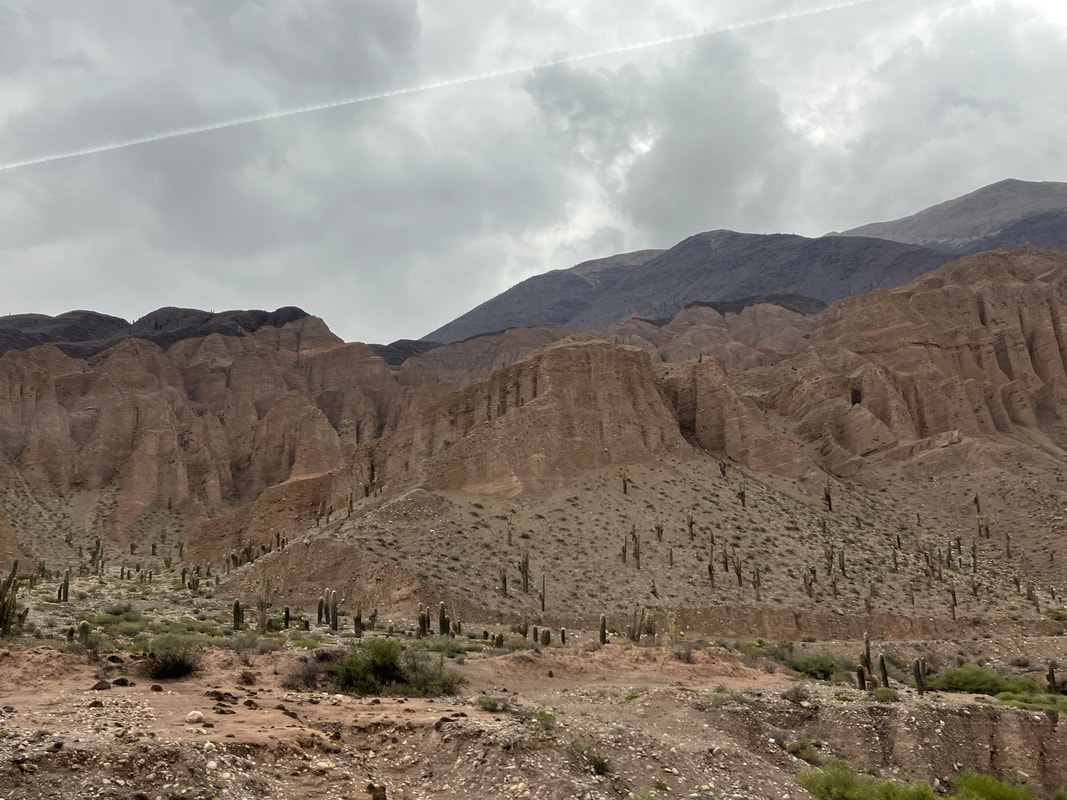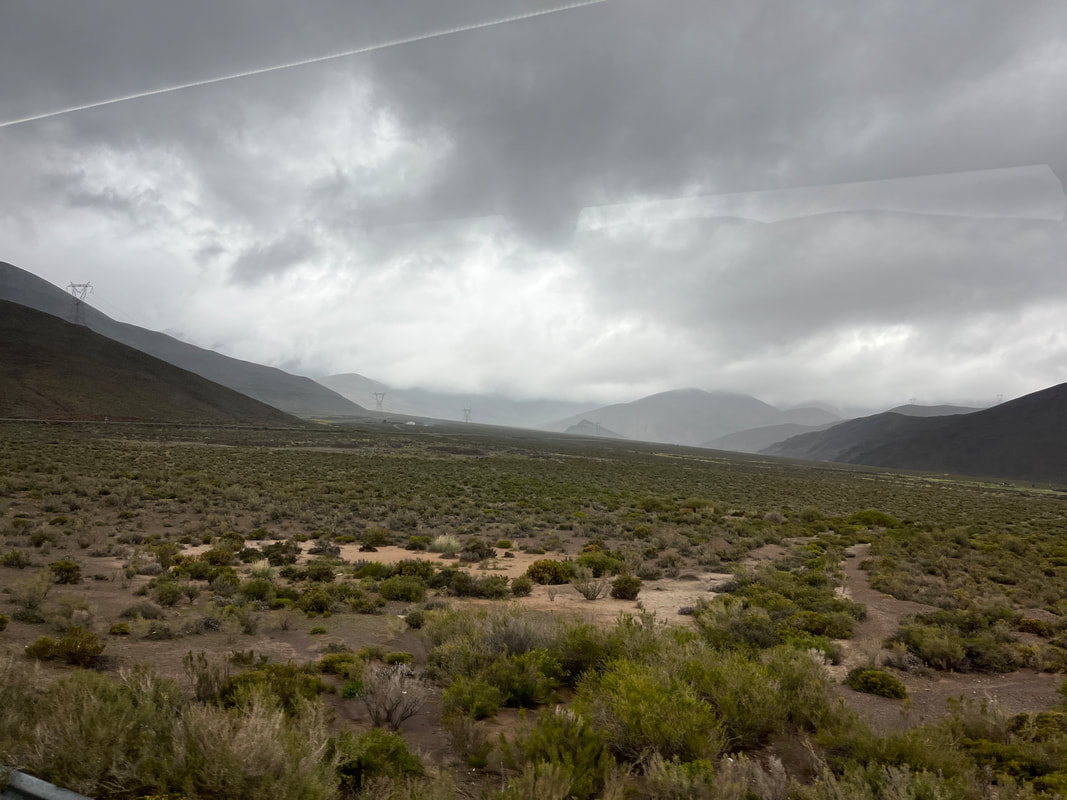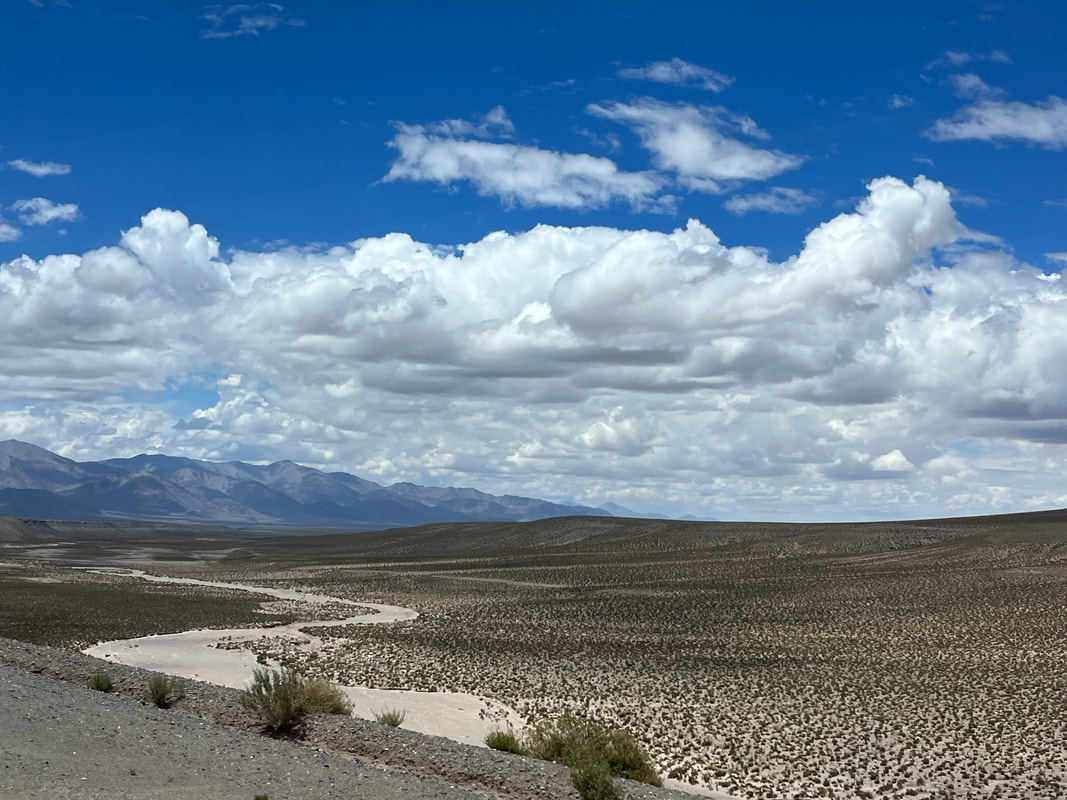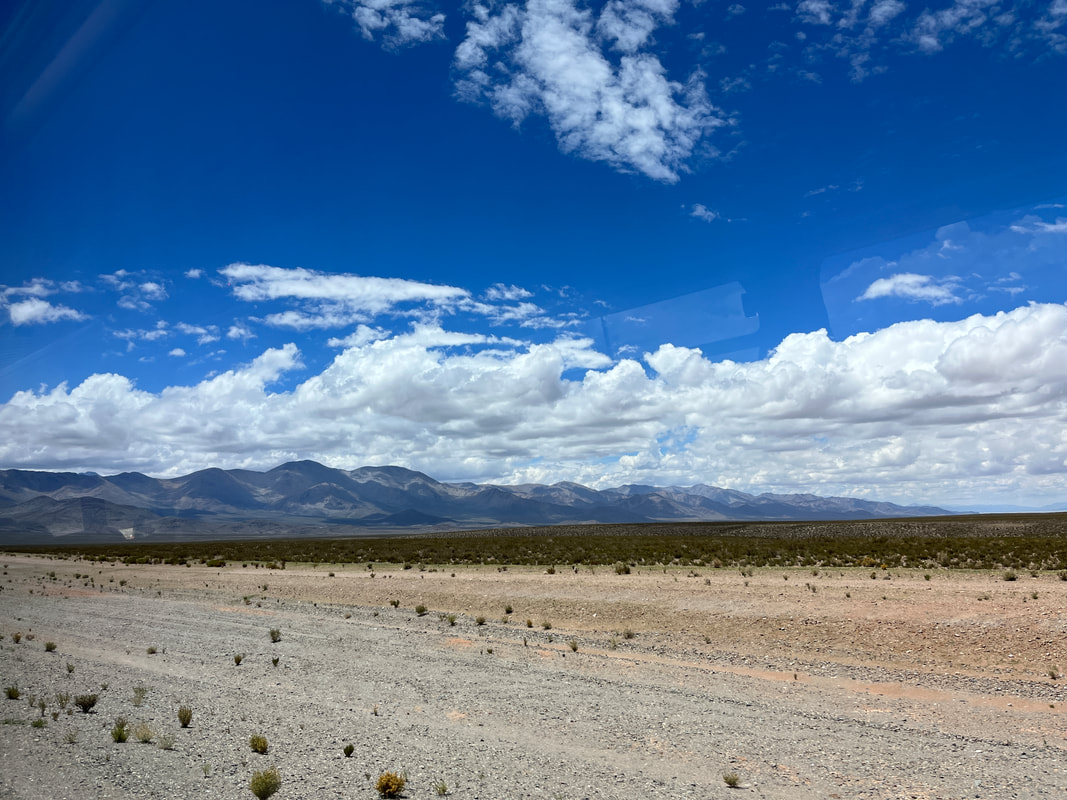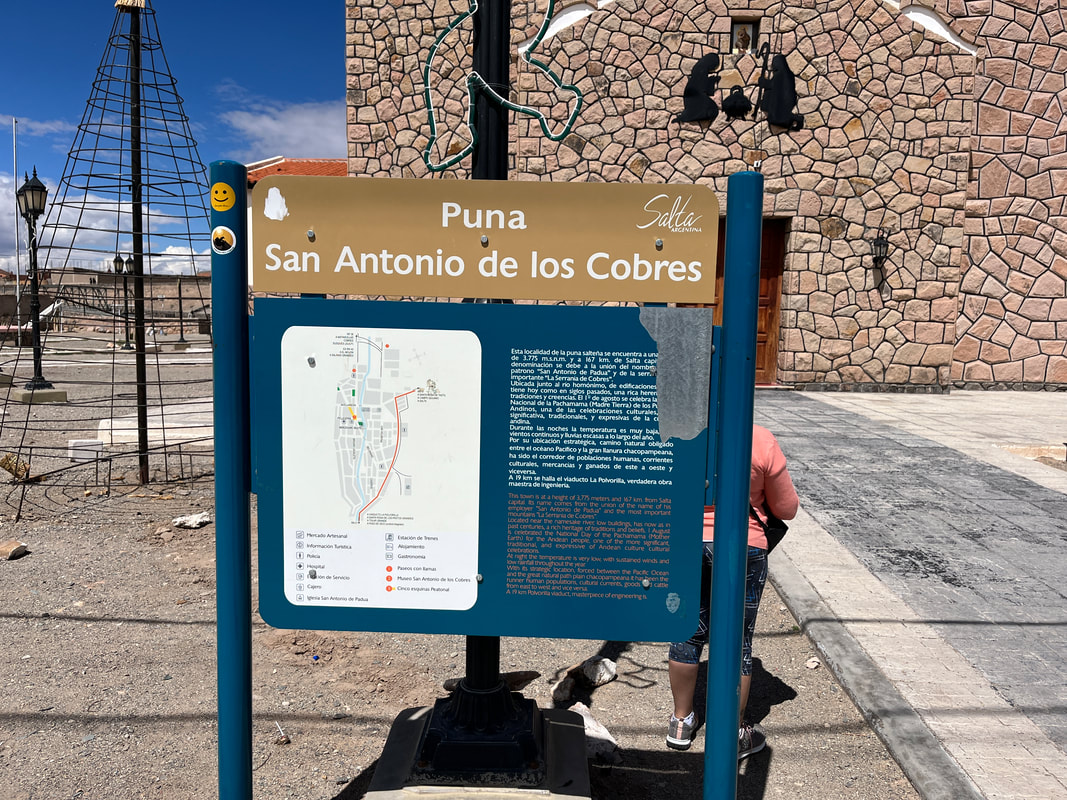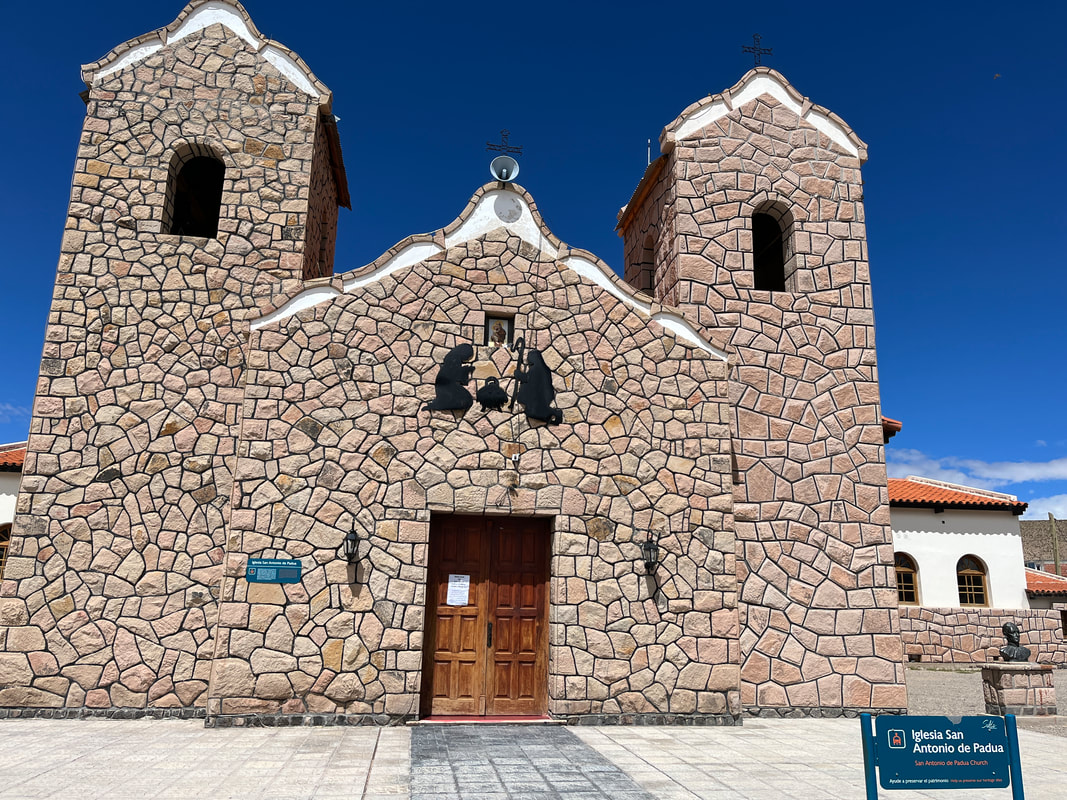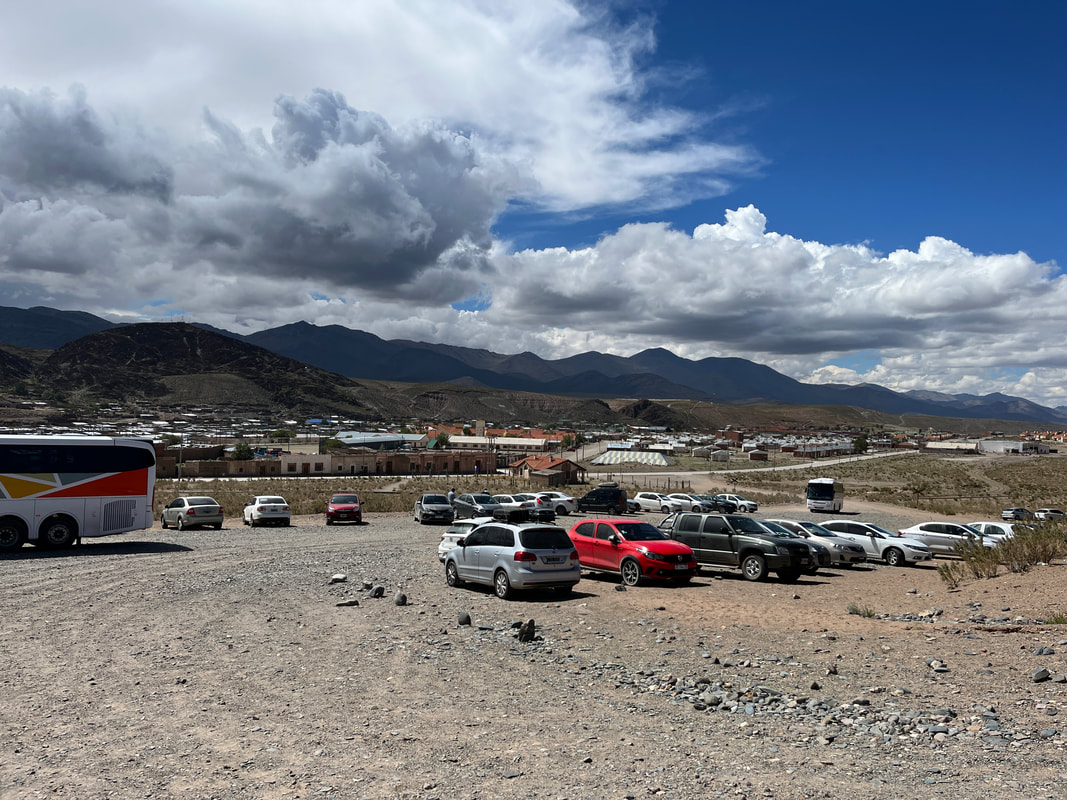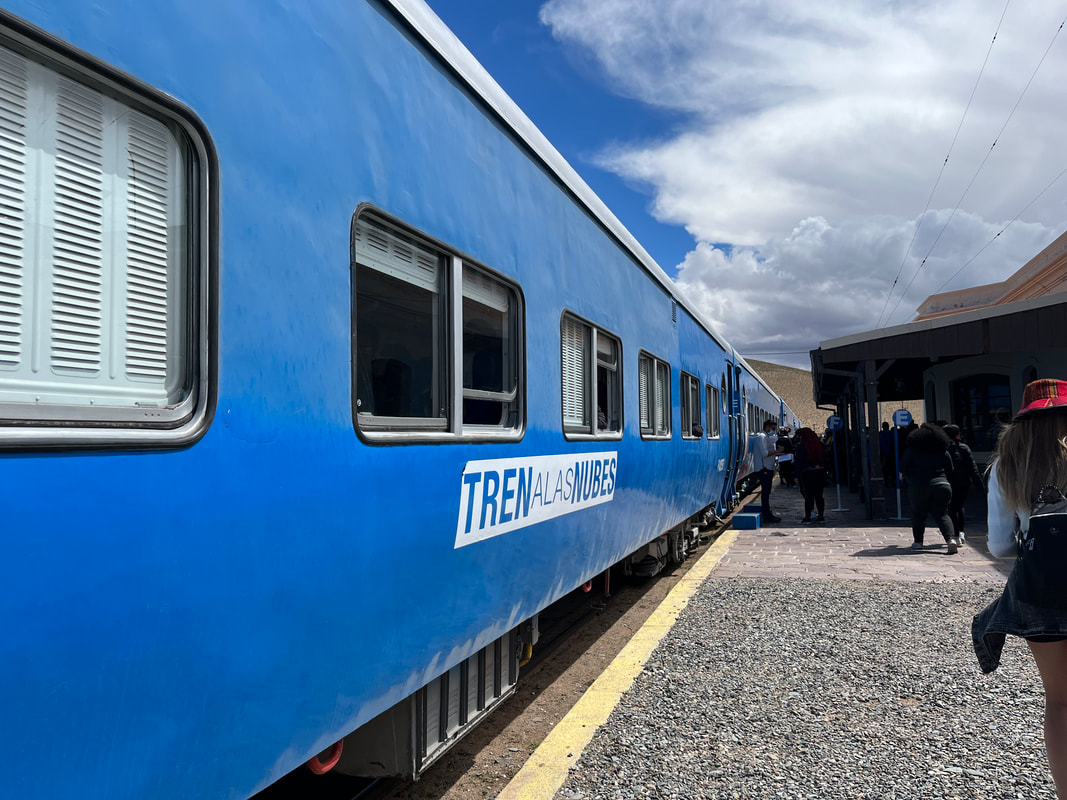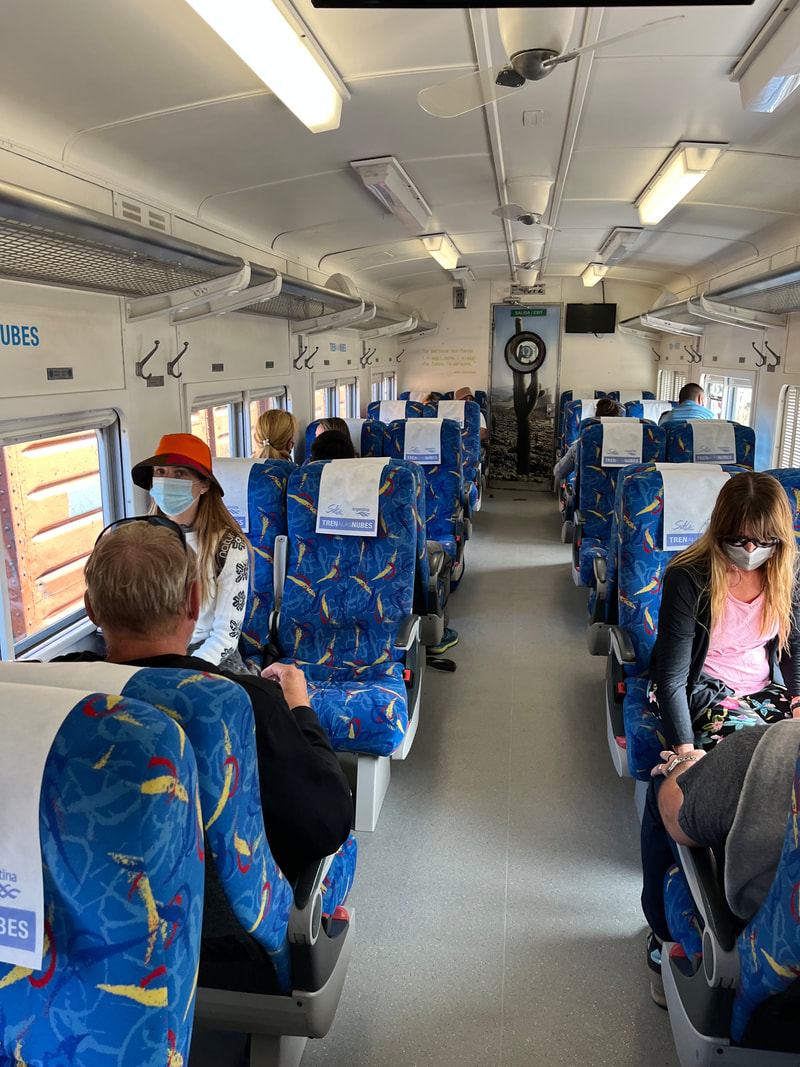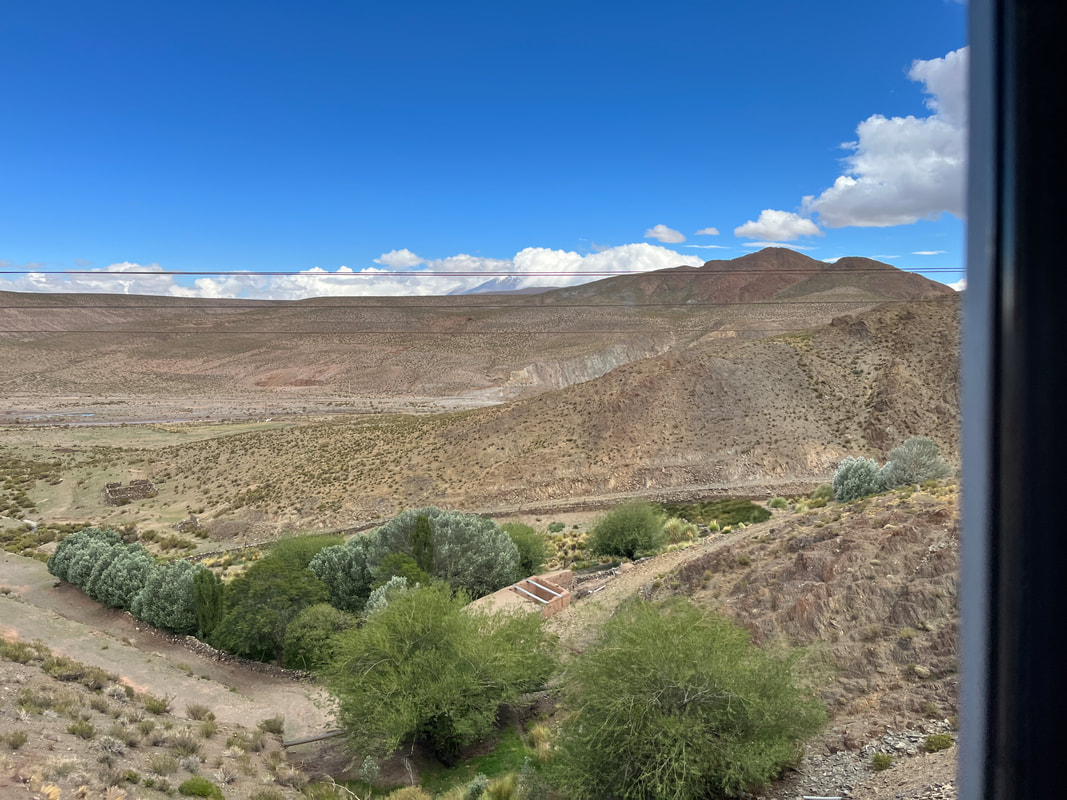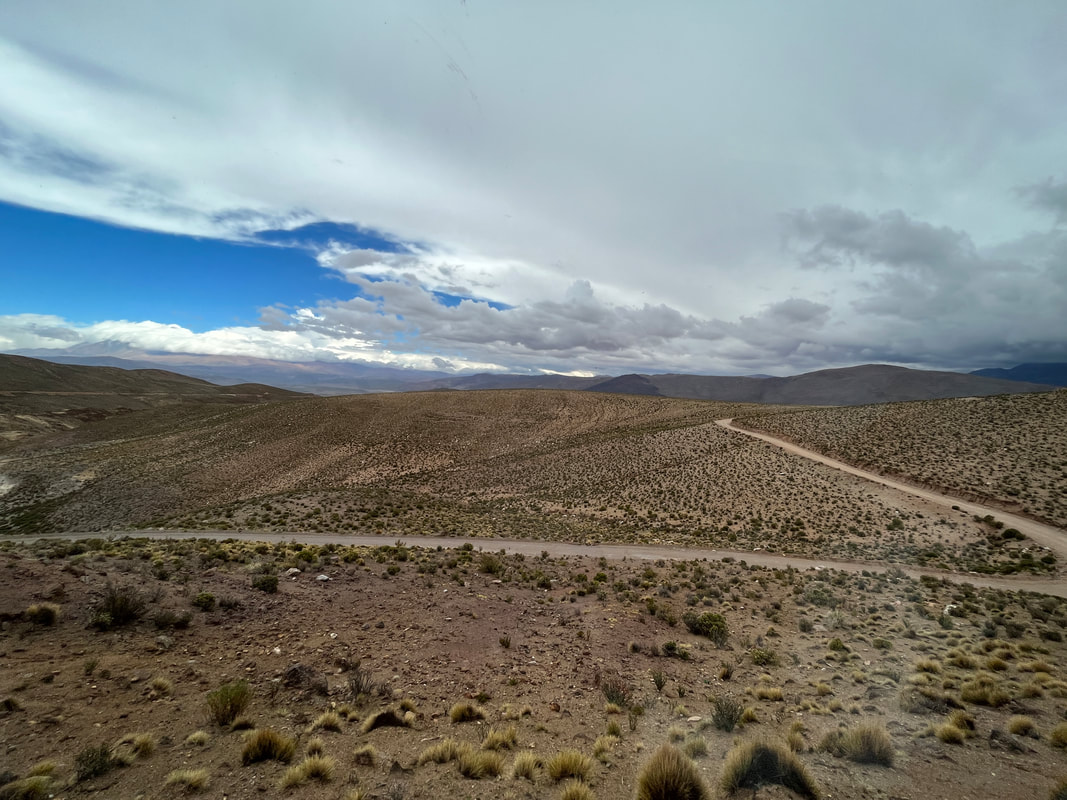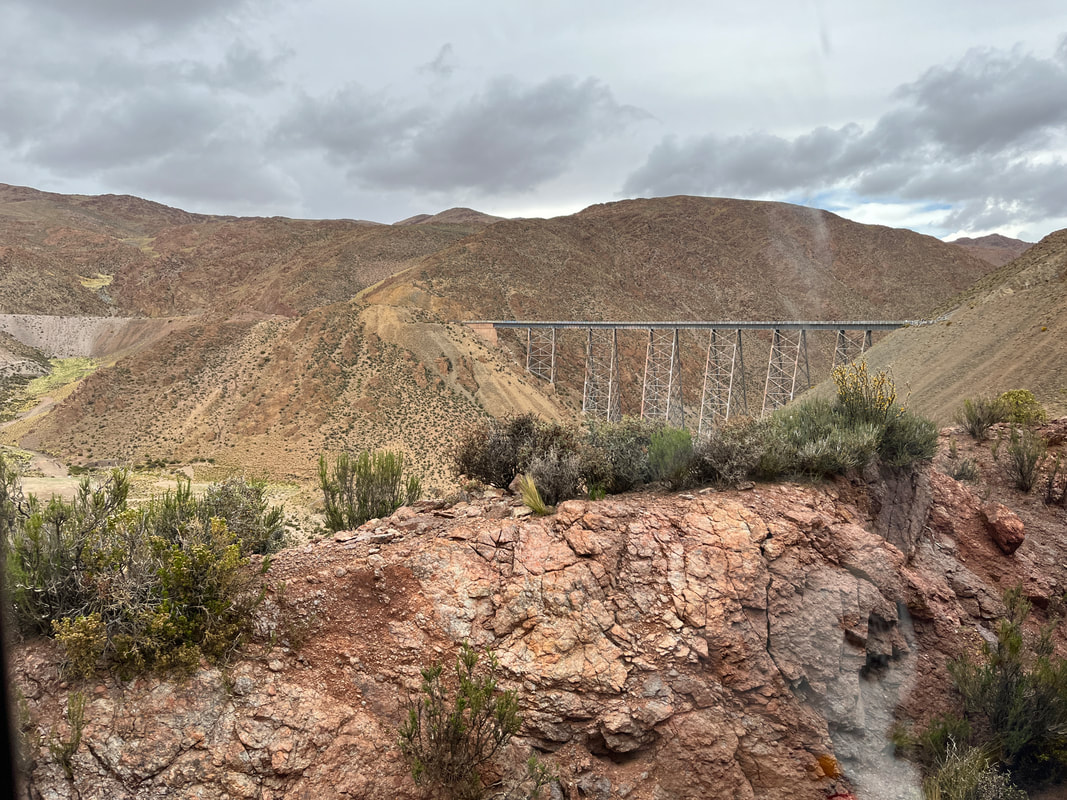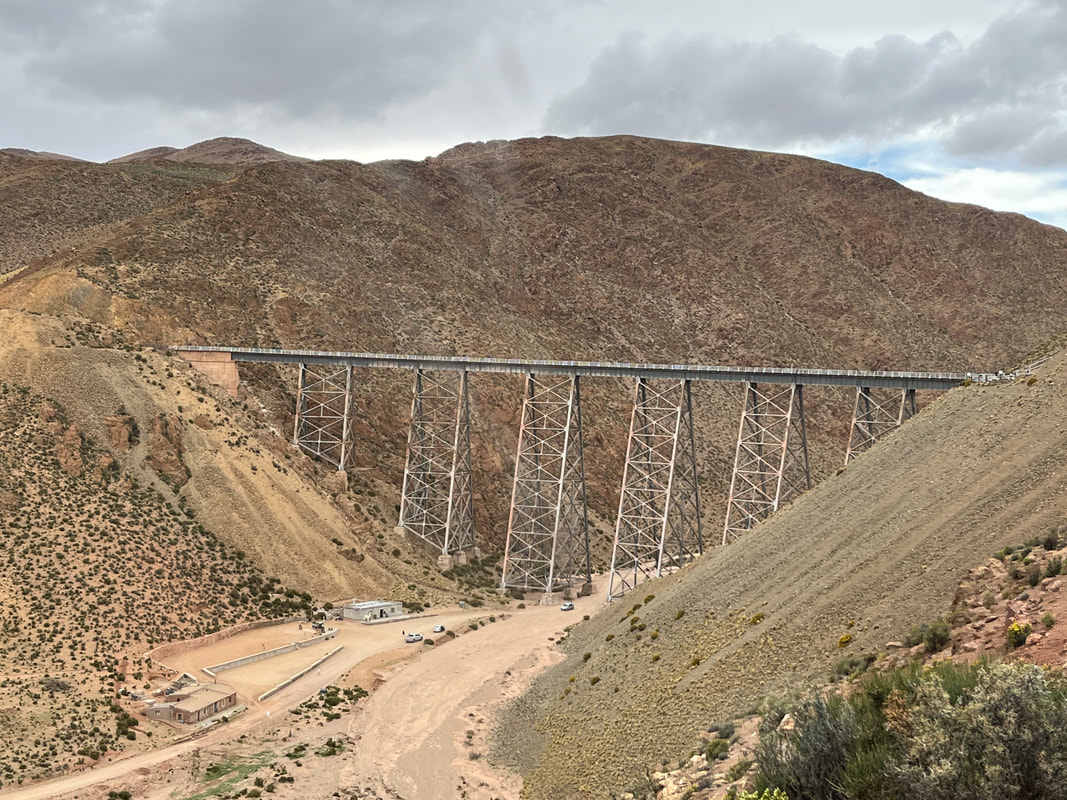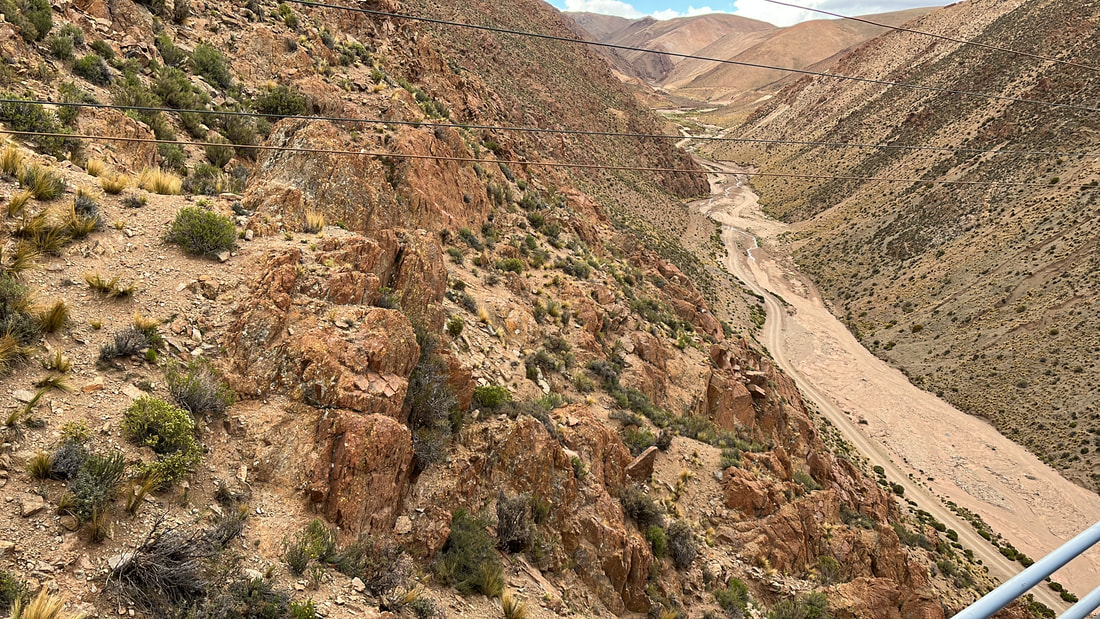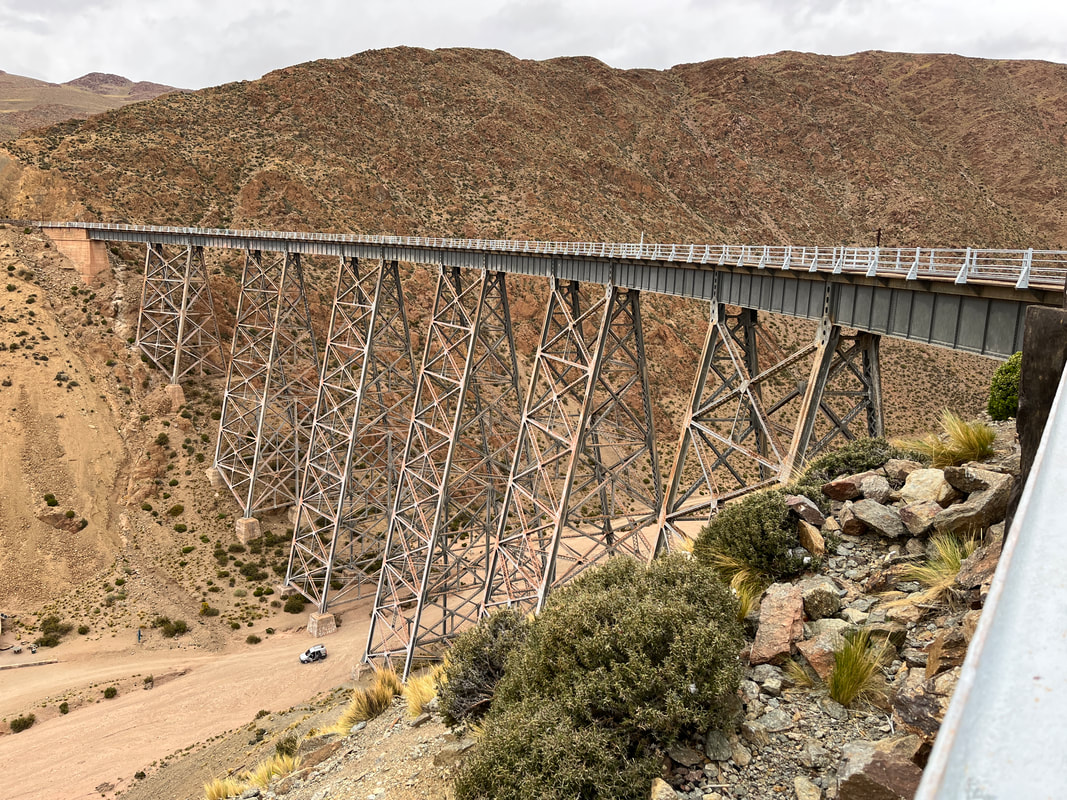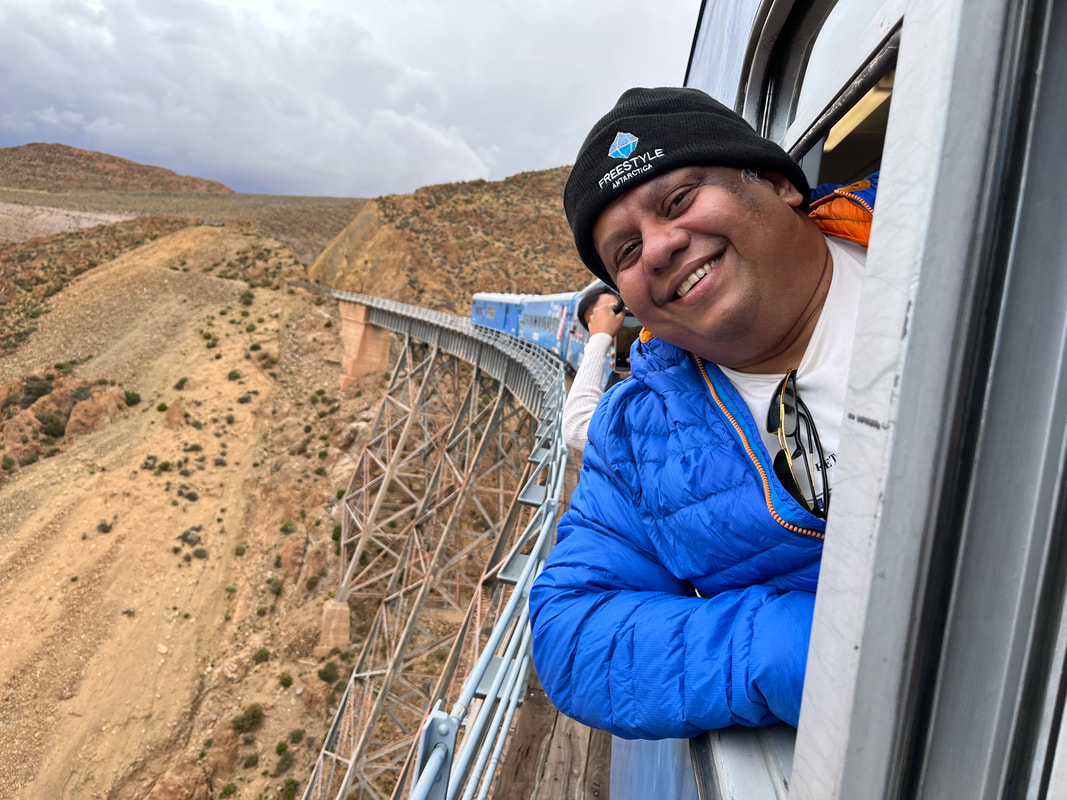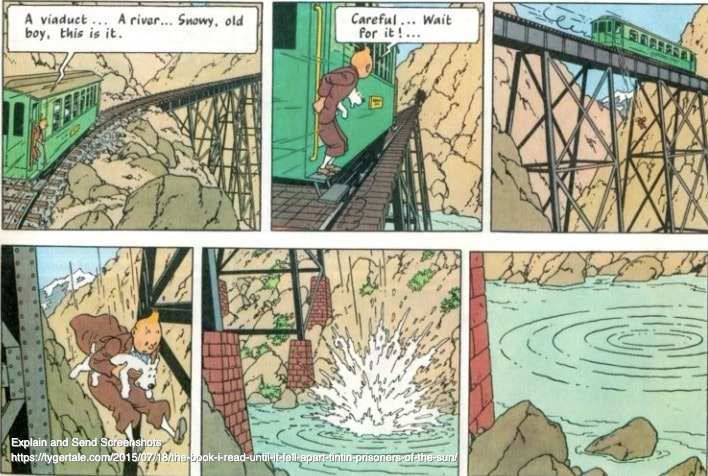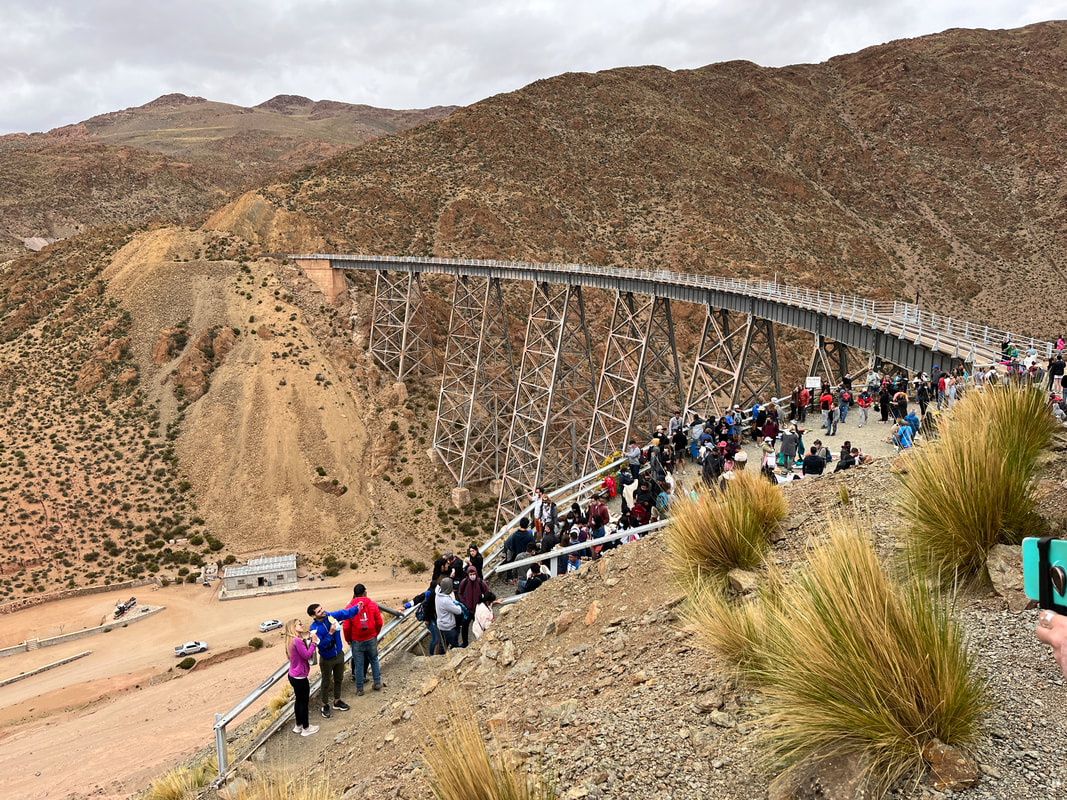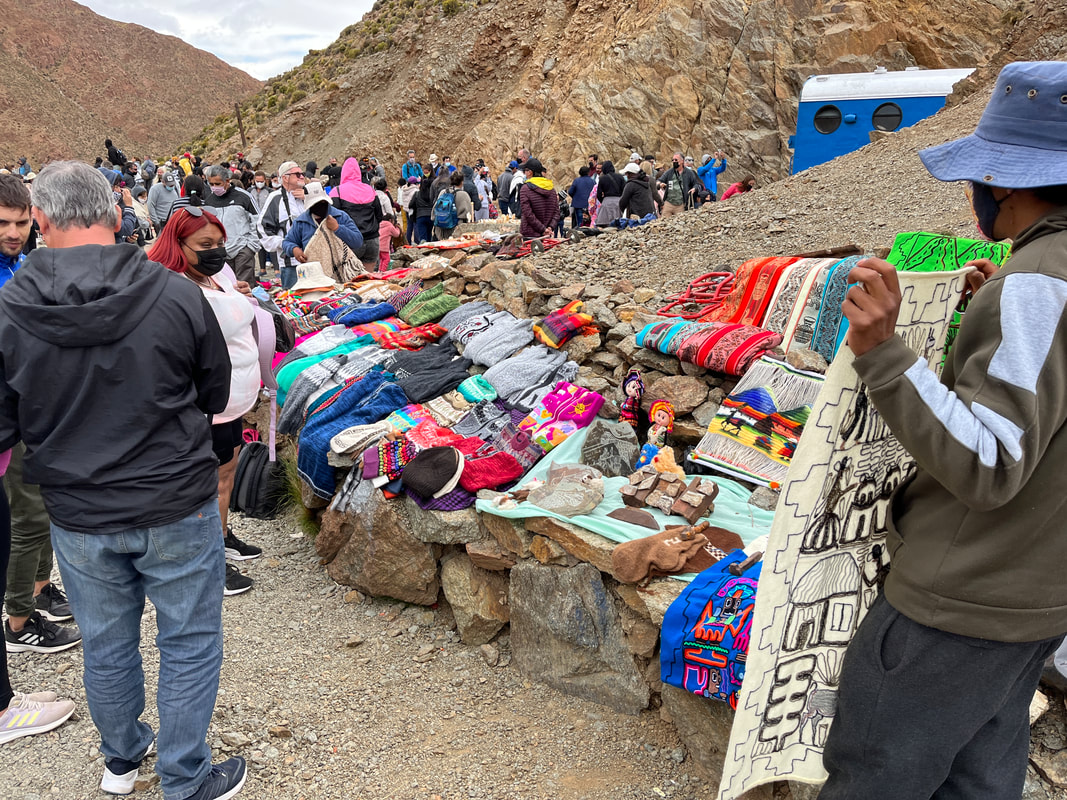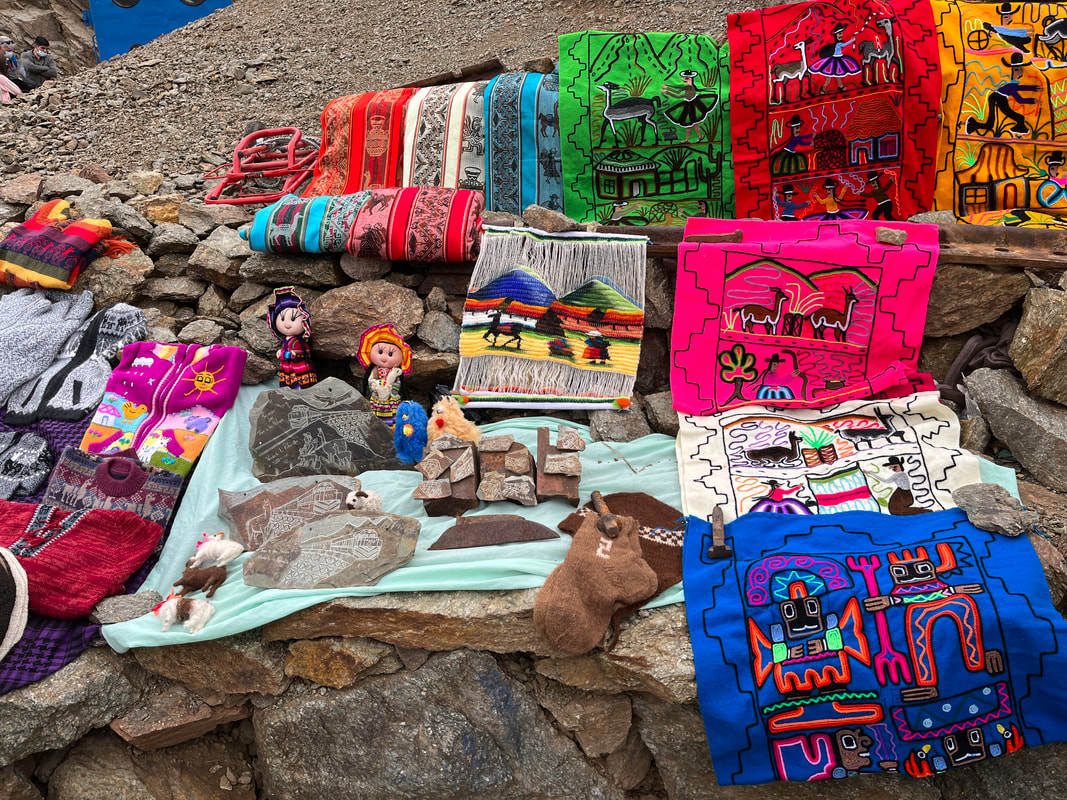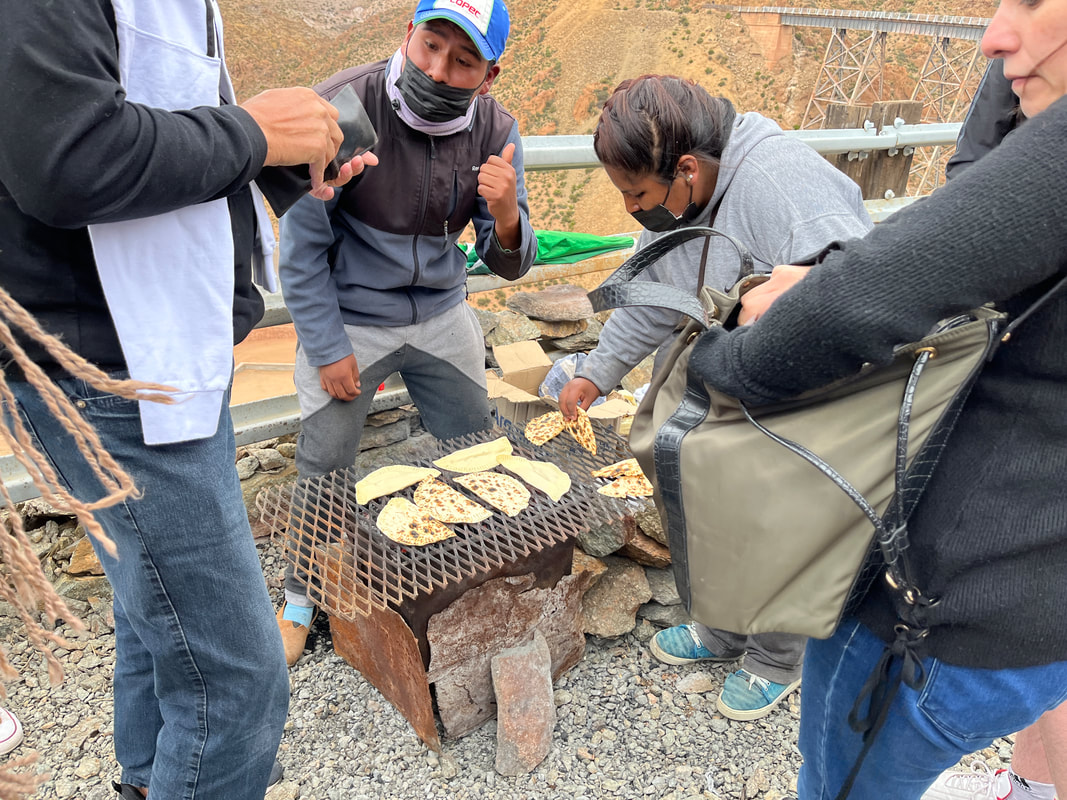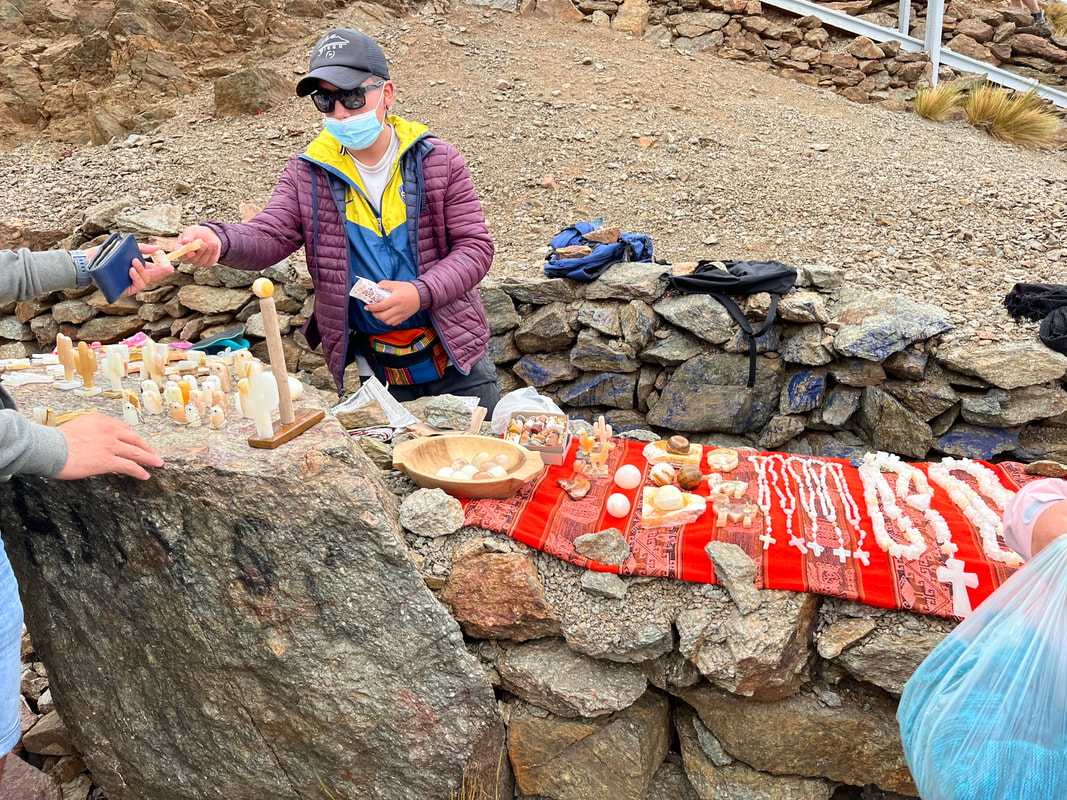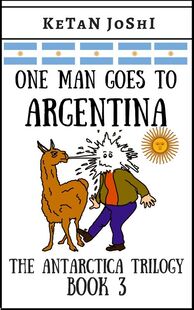The train in the clouds
the ‘Tren a las nubes’ - ‘The train to the clouds’. This is a famous tourist train which runs along the eastern part of the Salta–Antofagasta railway line of the Belgrano Railway that connects the Argentine Northwest with the border in the Andes mountain range, over 4,220 metres (13,850 ft) above mean sea level! This makes it the fifth highest railway in the world!
The final ticket gave me my bus number and train seat number - and I went out to find it. And was rather taken aback to find a whole fleet of buses there! Wow! I had no idea that this train was so famous and popular - with locals! I found my bus, and the driver politely asked me to wait for the guide. To be precise, he gestured and waggled his head - because he spoke only spanish. Soon a very nice guide came up and spoke to me in very good English.
’This bus is only for foreigners’ he explained ‘That’s why I have been assigned to this bus. I will explain everything in English as well as Spanish.’
’This bus is only for foreigners’ he explained ‘That’s why I have been assigned to this bus. I will explain everything in English as well as Spanish.’
But why was I on a bus - at a railway station? When I was booked to go on a ride on a train?
The answer was that the railway station was no longer working as railway station - all trains had stopped, the poor things.
This line used to be one of the great railway lines in the world - The Salta–Antofagasta railway, a non-electrified single track railway line that linked Argentina and Chile passing through the Andes - a 1000 km long line!), connecting the city of Salta (Argentina) to the one of Antofagasta (Chile), on the Pacific Ocean, passing through the Puna de Atacama and Atacama Desert!
But alas, this beautiful line no longer runs trains. It was built mainly to service the copper and borax mines in the high mountains. But the mines closed after a terrible accident - and the train was no longer viable and it stopped running as a passenger or freight train.
It would be a real shame to abandon the line altogether - such a great engineering achievement which was built with so much labour and effort and expense - so the authorities kept it running as a tourist attraction.
The answer was that the railway station was no longer working as railway station - all trains had stopped, the poor things.
This line used to be one of the great railway lines in the world - The Salta–Antofagasta railway, a non-electrified single track railway line that linked Argentina and Chile passing through the Andes - a 1000 km long line!), connecting the city of Salta (Argentina) to the one of Antofagasta (Chile), on the Pacific Ocean, passing through the Puna de Atacama and Atacama Desert!
But alas, this beautiful line no longer runs trains. It was built mainly to service the copper and borax mines in the high mountains. But the mines closed after a terrible accident - and the train was no longer viable and it stopped running as a passenger or freight train.
It would be a real shame to abandon the line altogether - such a great engineering achievement which was built with so much labour and effort and expense - so the authorities kept it running as a tourist attraction.
I had scored an awesome seat just behind the driver - which meant that I would get the amazing views through the windshield - and was a bit disgruntled when the guide kicked me out of that seat because he wanted to assign it to a couple who wanted to sit together - and assigned me to the back of the bus. As I said - I was disgruntled!
But I immediately became gruntled again! Because this seat was next to a very pretty young girl! Woohoo!
The girl must have been shocked to see her neighbourhood invaded by an ugly fat guy from India - but my natural charm won her over ( Or maybe her kind heart made her sorry for me?) and soon we were chatting away. She must have been the only other person on the bus who could speak english (apart from the guide, of course) and it was a stroke of luck that we were sitting together. It turned out that she was a medical student, and she was on a holiday with her parents - whom she introduced to me. They took a keen glance at my paunch, my white hair and my general air of respectability and nodded approvingly.
Si si … ¡Muy bien! El vecino ideal. The ideal neighbour!
The girl and her family very hospitably invited me to join them for lunch, and we had empanadas and soft drinks in a small hotel. They asked me where I was from - and were quite impressed when I said that I was from India! Wow - a visitor from the other side of the world! Then they asked me what I did for a living - and were even more impressed when I told them that I was a writer, and had published 17 books!
¡Muy bien! el autor!
They refused to allow me to pay for the meal. ‘You are our guest, señor!’ What lovely people.
But I immediately became gruntled again! Because this seat was next to a very pretty young girl! Woohoo!
The girl must have been shocked to see her neighbourhood invaded by an ugly fat guy from India - but my natural charm won her over ( Or maybe her kind heart made her sorry for me?) and soon we were chatting away. She must have been the only other person on the bus who could speak english (apart from the guide, of course) and it was a stroke of luck that we were sitting together. It turned out that she was a medical student, and she was on a holiday with her parents - whom she introduced to me. They took a keen glance at my paunch, my white hair and my general air of respectability and nodded approvingly.
Si si … ¡Muy bien! El vecino ideal. The ideal neighbour!
The girl and her family very hospitably invited me to join them for lunch, and we had empanadas and soft drinks in a small hotel. They asked me where I was from - and were quite impressed when I said that I was from India! Wow - a visitor from the other side of the world! Then they asked me what I did for a living - and were even more impressed when I told them that I was a writer, and had published 17 books!
¡Muy bien! el autor!
They refused to allow me to pay for the meal. ‘You are our guest, señor!’ What lovely people.
The guide stared telling us the story of the train.
‘While this train is called ‘la tren a las nubes’ - ‘the train in the clouds’ - there are actually no clouds. The train does not go through any clouds!’
‘Eh?’ I was startled.
‘The line got its name in the early 1960s after students filmed a trip on the Salta-Antofagasta railway from inside the train carriages, often showing the vapor from the then-steam locomotive which – together with the cold mountain air – formed large vapour plumes. The footage was later offered to the Clarín newspaper to make a documentary, which was subsequently called Tren a las Nubes (Train to the Clouds) because of the vapour clouds in the film. Ferrocarriles Argentinos (the train company) later adopted the name to make it more appealing to tourists.
So if you have come here because of the name, then you have been seduced by marketing! Hahaha! SUCKAS!’
‘While this train is called ‘la tren a las nubes’ - ‘the train in the clouds’ - there are actually no clouds. The train does not go through any clouds!’
‘Eh?’ I was startled.
‘The line got its name in the early 1960s after students filmed a trip on the Salta-Antofagasta railway from inside the train carriages, often showing the vapor from the then-steam locomotive which – together with the cold mountain air – formed large vapour plumes. The footage was later offered to the Clarín newspaper to make a documentary, which was subsequently called Tren a las Nubes (Train to the Clouds) because of the vapour clouds in the film. Ferrocarriles Argentinos (the train company) later adopted the name to make it more appealing to tourists.
So if you have come here because of the name, then you have been seduced by marketing! Hahaha! SUCKAS!’
The bus followed the iconic e Route 51 - the road connecting Argentina with northern Chile. It runs at heights more than 4500 meters above sea level and through a deep gorge surrounded by beautiful mountains and formations. Most of route 51 goes through The Toro Gorge, or the Quebrada del Toro.
We were entering the ‘Puna’ - a high treeless plateau in the Peruvian Andes.
The original railway line passed over a high viaduct built over the gorge, and we stopped below this to admire the river and the railway bridge. This river used to be called the ‘Black river’ because it brought down a lot of alluvium and suspended particles from its journey down the Andes.
The railway bridge - the guide informed us - was actually designed by Gustave Eiffel, of Eiffel tower fame!
Eiffel - though now remembered mainly for the Eiffel tower in Paris - was an engineering genius who worked on various projects including buildings, railway stations, a huge number of railway bridges and - the Statue of Liberty!
He had worked on a system of standardised prefabricated bridges - These used a small number of standard components, all small enough to be readily transportable in areas with poor or non-existent roads, and were joined using bolts rather than rivets, reducing the need for skilled labour on site. A number of different types were produced, ranging from footbridges to standard-gauge railway bridges.
This particular project was an all-metal prefabricated building, manufactured in France and shipped to South America in pieces to be assembled on site - like the world’s biggest Meccano kit!
We were entering the ‘Puna’ - a high treeless plateau in the Peruvian Andes.
The original railway line passed over a high viaduct built over the gorge, and we stopped below this to admire the river and the railway bridge. This river used to be called the ‘Black river’ because it brought down a lot of alluvium and suspended particles from its journey down the Andes.
The railway bridge - the guide informed us - was actually designed by Gustave Eiffel, of Eiffel tower fame!
Eiffel - though now remembered mainly for the Eiffel tower in Paris - was an engineering genius who worked on various projects including buildings, railway stations, a huge number of railway bridges and - the Statue of Liberty!
He had worked on a system of standardised prefabricated bridges - These used a small number of standard components, all small enough to be readily transportable in areas with poor or non-existent roads, and were joined using bolts rather than rivets, reducing the need for skilled labour on site. A number of different types were produced, ranging from footbridges to standard-gauge railway bridges.
This particular project was an all-metal prefabricated building, manufactured in France and shipped to South America in pieces to be assembled on site - like the world’s biggest Meccano kit!
The road went through landscapes of incredible scenery and then we stopped at a village called El Alfarcito for a bite. This is a charming little town with a tiny white church (which was closed) , a small indigenous museum (which was rather pointless), and various shops selling artisanal crafts (which were closed)
The tour had partnered with the villagers to provide coffee and snacks to the bus passengers - and that was clearly a major revenue earner for the town.
‘This used to be a octroi point for taxing trade in ancient times.’ The guide explained ‘all trade from the mountains to the plains has to pass through this pass, and the tribe which lived here exacted taxes on the trade.’
Looks like the coffee contract was the new equivalent of trade tax!
The tour had partnered with the villagers to provide coffee and snacks to the bus passengers - and that was clearly a major revenue earner for the town.
‘This used to be a octroi point for taxing trade in ancient times.’ The guide explained ‘all trade from the mountains to the plains has to pass through this pass, and the tribe which lived here exacted taxes on the trade.’
Looks like the coffee contract was the new equivalent of trade tax!
After that we were driving through the beautiful highland desert, the Puna de Atacama (Atacama Platau). With an average elevation of 3500+m and a span of just under a few hundred thousand square kilometers, it is considered a massive highland desert between Argentina’s northeast and a bit of Chile and Bolivia too.
Soon after, we reached the highest point of the Route 51 and the place where the whole Toro Gorge begins, Abra Blanca. Abra Blanca is the highest point of the area at 4080m, and you can take a photo with a sign that says this. From this point, you can say goodbye to the gorge and hello to the beautiful Argentinian highlands.
The scenery changes as you enter the Puna de Atacama, with the cacti and interesting rock formations of the gorge traded for a vast expanse of yellow and orange flatlands bordered by red, blue, and purple mountains.
Soon after, we reached the highest point of the Route 51 and the place where the whole Toro Gorge begins, Abra Blanca. Abra Blanca is the highest point of the area at 4080m, and you can take a photo with a sign that says this. From this point, you can say goodbye to the gorge and hello to the beautiful Argentinian highlands.
The scenery changes as you enter the Puna de Atacama, with the cacti and interesting rock formations of the gorge traded for a vast expanse of yellow and orange flatlands bordered by red, blue, and purple mountains.
And finally - finally - we reached the town of San Antonio de Los Cobres.
‘Cobras?’ I looked at it doubtfully. A snaky saint? Or should I say… ssssssaint? Heh.
But no - it’s not cobra, it’s ‘Cobres’ - ‘Copper’. San Antonio de las Cobres takes its name from the nearby Sierra de Cobre, or Copper Mountain, which is rich in that mineral. Economic activity in the town is based on mining of the mineral-rich surrounding mountains, and weaving using local llama wool.
‘Cobras?’ I looked at it doubtfully. A snaky saint? Or should I say… ssssssaint? Heh.
But no - it’s not cobra, it’s ‘Cobres’ - ‘Copper’. San Antonio de las Cobres takes its name from the nearby Sierra de Cobre, or Copper Mountain, which is rich in that mineral. Economic activity in the town is based on mining of the mineral-rich surrounding mountains, and weaving using local llama wool.
As the train began, we were presented with INCREDIBLE views of the unique highland desert, the Puna de Atacama. This flatland has an average altitude of 3500m, and is lined with watercolour-like mountains that can reach up to 6000m. As the train gained speed, we could see miles and miles of fairly barren landscapes, with colors that were bright and blotched with different colors. Over the loud speaker, we got little tidbits of history and info about this train, which is a true engineering marvel.
The train wound round and round the highlands for a while. The other passengers and I gaped wide-eyed at the views. We passed some salty springs, and also an old mineral mine that used to extract silver, copper, lead, and zinc from the colourful landscape until 1985.
After the mine, the final stop of the Tren a Las Nubes was the most famous – the Viaducto la Polvorilla, or the Polvorilla Viaduct. This is definitely the most photographed and possibly the most impressive part of the Train to the Clouds.
The Viaducto la Polvorilla is a massive, 64m high, 232m long viaduct over a deep canyon in the mountains. The train curves to the left over this viaduct, leaving an absolutely flawless photo op of the train, the viaduct, and the canyon!
The Viaducto la Polvorilla is a massive, 64m high, 232m long viaduct over a deep canyon in the mountains. The train curves to the left over this viaduct, leaving an absolutely flawless photo op of the train, the viaduct, and the canyon!
Everyone on the train knows this, too, because each and every one of them sticks their entire body out the window with a selfie stick as the train nears the viaduct. But, can you blame them?! The view is pretty damn awesome, incredibly unique, and basically just jaw-dropping.
‘This looks so familiar’ I thought. ‘I am sure I have seen this before! But where?’
Then suddenly it flashed to me - this was just like the railway scene in Tintin in ‘Prisoners of the Sun’.
‘This looks so familiar’ I thought. ‘I am sure I have seen this before! But where?’
Then suddenly it flashed to me - this was just like the railway scene in Tintin in ‘Prisoners of the Sun’.
Then it was time for another stop. Just next to the viaduct, there were dozens of locals who had spread out blankets full of indigenous crafts, Inca art, and the classic South America sweaters. The whole train load of tourists swarmed out and stood on the viewpoint, and the patriotic train people hoisted the Argentine flag and everyone stood there and sang the national anthem. I just stood there. Because I didn’t know their national anthem.
After this patriotic interlude, we scrambled back into the train and made our way back to San Antonio - the cobra saint! Ssssss.
After this patriotic interlude, we scrambled back into the train and made our way back to San Antonio - the cobra saint! Ssssss.
Then it was time to drive back! This time there was no stopping anywhere and we drive straight back to town - and I discovered the terrible power of the setting sun in Argentina!
The rays came through at a very low angle and hit me straight in the face for the entire journey! It was like one of those police interrogation techniques! It left me sunburnt, sun-blinded and absolutely frazzled at the end of a very long day!
But it had been a great day! A wonderful day!
I had seen the most amazing places and met the most friendly people.
What more can one ask of travel?
The rays came through at a very low angle and hit me straight in the face for the entire journey! It was like one of those police interrogation techniques! It left me sunburnt, sun-blinded and absolutely frazzled at the end of a very long day!
But it had been a great day! A wonderful day!
I had seen the most amazing places and met the most friendly people.
What more can one ask of travel?

